Frogs and toads are abundant in Texas. Some of the most common North American toads and frogs live in the state.
A series of species from Central America has also made it to the state.
Some species are more adapted than others. Generally, frogs and toads in Texas live anywhere between 1 and 10 years.
All amphibians in the state are tied to rain, humidity, and sources of water, essential elements for reproduction.
Texas is a unique habitat for frogs and toads for 3 main reasons.
- A good rainy season
Texas has at least one good rainy season from March to May. This is a common breeding period for frogs and toads.
Periods from September to October can also be rainy in Texas, a good time for frogs and toads to make their appearance and mate again,
- A combination of oceanic and arid/desert climates
The oceanic climate is specific to the Eastern parts of Texas. Arid climates are specific to the Western parts of the state.
The combination of such diverse climates with considerable humidity and temperature variation makes the state a good habitat for a wide range of frogs and toads.
- Mild winters
Lower Rio Grande Valley is a Southern region of the state known for its mild winters.
Located on the Gulf Coast, it provides a good habitat for specific species such as the Gulf Coast Toad.
With a warmer climate and mild winters compared to many other US states, Texas is one of the states with the highest numbers of frogs and toads in the country.
Most species have stable populations across the state while others are declining in numbers, mainly due to diminishing habitats.
Mexican Smilisca is one of the species with an endangered status in Texas.
Table of Contents
Are There Poisonous Frogs and Toads in Texas?
Most frogs and toads in Texas aren’t poisonous but there are at least 2 species with poison glands that people and animals need to be aware of.
Pickerel Frogs are the only truly poisonous species in Texas when touched. It releases toxins through its skin.
These toxins can cause skin irritation and eye irritation in humans. Animals can also suffer from irritating symptoms when in contact with the frog.
These toxins are only released through its skin when the frog feels endangered. They can also be released when it sees humans or when people handle them.
Cane Toads are also poisonous, but only to animals and only when swallowed. They have parotoid glands which are irritating and very dangerous to animals.
Other frogs licking Cane Toads or pests that lick these toads can suffer irritation, confusion, and internal bleeding.
Frogs and Toads in Texas
Some of the most common frogs and toads in Texas include the following species.
1. Gulf Coast Toad
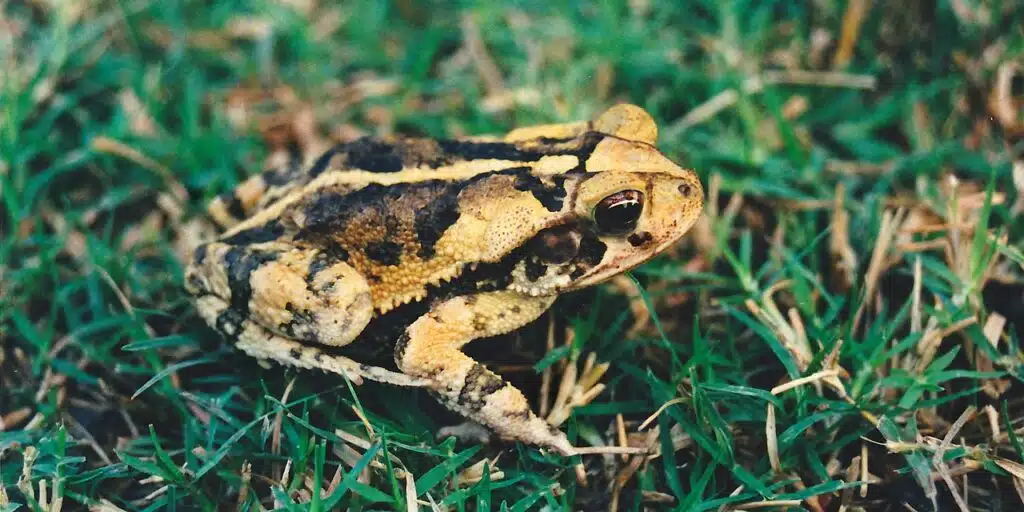
Gulf Coast Toads (Incilius nebulifer) are named after their natural habitat. They live in moist areas around the Gulf Coast both in Mexico and in the US.
Gulf Coast Toads are considered some of the largest types of toads in Southeastern US habitats.
This species has dark brown and cream coloring and it’s among the species known to tolerate salt water.
It can be spotted in different habitats, including around human settlements.
Gulf Coast Toads also lay thousands of eggs in ditches or next to water sources.
Roadsides are a common sight for the species.
Many man-made humid habitats such as orchards and farms with irrigation are also known to attract these types of toads.
Finding the toads isn’t complicated as they tend to congregate in groups.
Males are seen together making sounds that last up to a few seconds.
This is a type of mating call ritual where male Gulf Coast Toads are seen together.
2. Green Treefrog
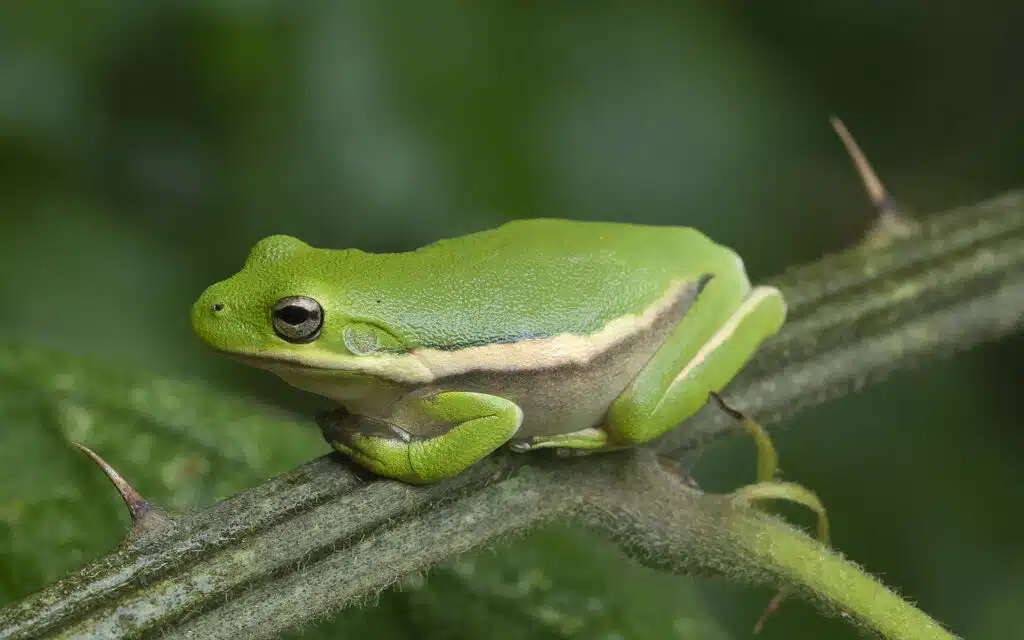
Green Treefrogs (Hyla cinerea) are some of the most common arboreal species in Central and Southeastern US habitats.
High color variation is specific to the Green Treefrog. All of its colors are uniform without dots or patterns except for the lateral cream bands.
This species is seen in a green form, mostly as a juvenile. It can also be gray and brown.
Permanent bodies of water are among the common habitats of the species.
Marshes are among the common habitats of the species known to live on bodies of water with plenty of vegetation.
These types of frogs are also attracted to lights. They can make it to homes at night or they can be found in high numbers under street lights.
Frogs of this genus also make call noises which last at least 2 seconds.
3. Blanchard’s Cricket Frog
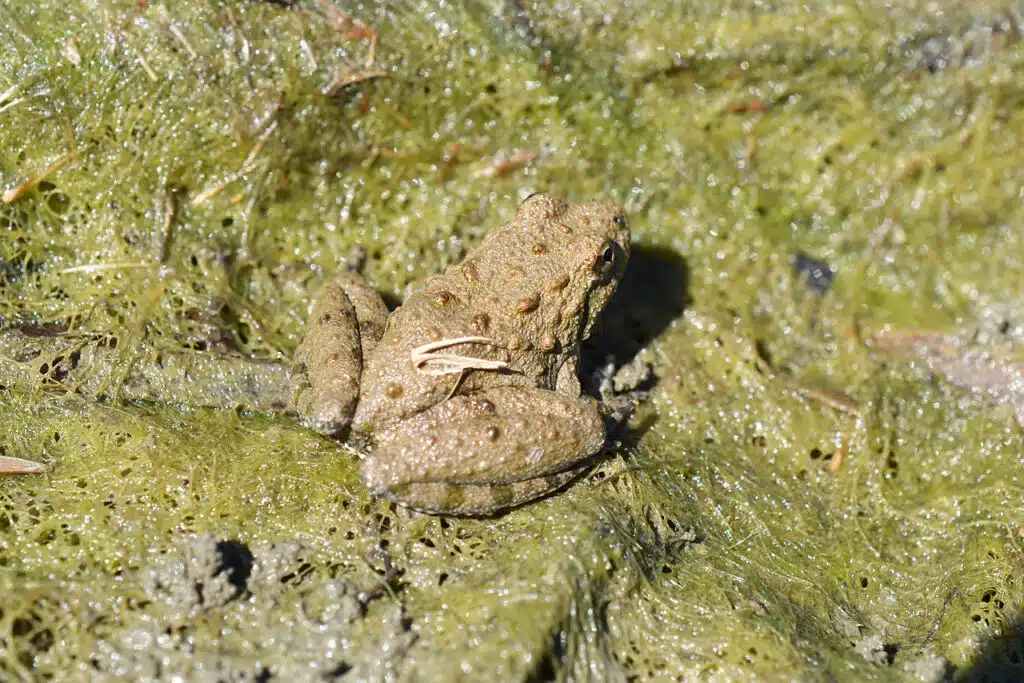
Permanent bodies of water in the Midwest United States are known habitats for Blanchard’s Cricket Frog (Acris blanchardi).
This is a short-lived species as it only survives for 1 year.
It enters hibernation in mid-fall only emerging again in the spring.
What was once considered a widespread species is now seen as a diminishing number of species as Blanchard’s Cricket Frog sightings are now not as common.
This species is believed to be impacted by bullfrogs in competition for food. Overlapping habitats are believed to drive the numbers of Blanchard’s Cricket Frogs down.
Slow-moving streams are known to attract these frogs as living habitats and as breeding grounds.
Blanchard’s Cricket Frogs have a distinct call that makes for easy identification even without being seen.
A metal-clicking sound is specific to the male call of the species.
4. American Bullfrog
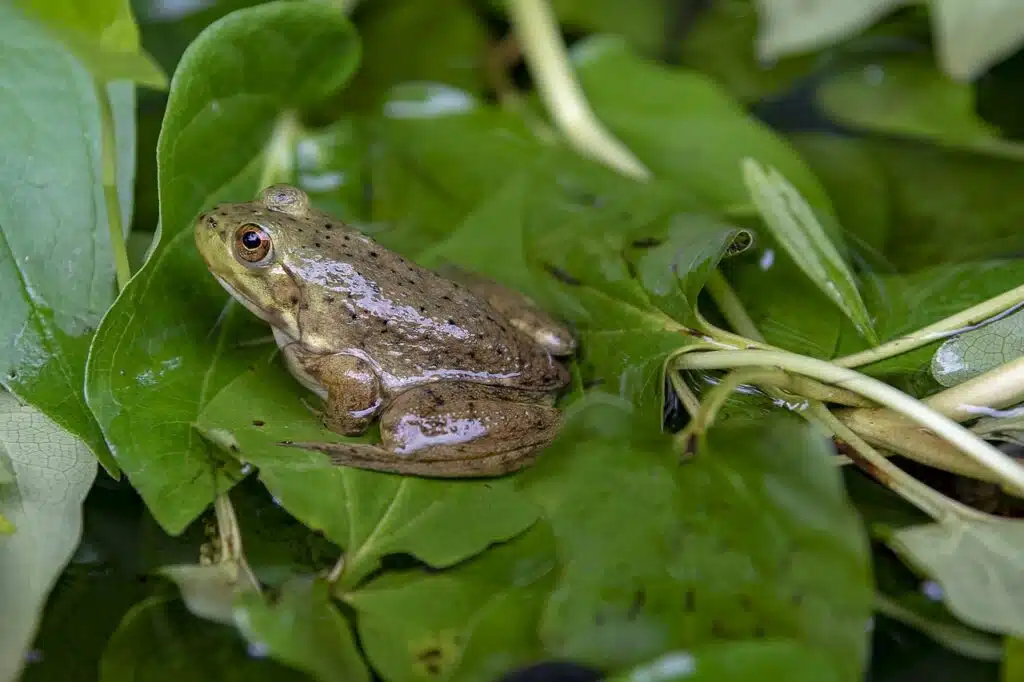
American Bullfrogs (Lithobates catesbeianus) are some of the most common species in North America.
The growing number of American Bullfrogs even makes them one of the most common species used in education.
This species is known for its calls which resemble the stomach sounds of bulls. Males gather in aggregations known as choruses.
While many American Bullfrog males are seen in groups, these types of interactions are marked by high aggression levels.
Some of the most dominant male American Bullfrogs are known to interact in fights. They first inflate their bodies to appear larger, as physical dominance matters most.
These types of bullfrogs have a varied diet based on opportunistic feeding.
The prey they eat differs from one day to another. They can eat small rodents one day to eat crayfish the following day.
5. Southern Leopard Frog
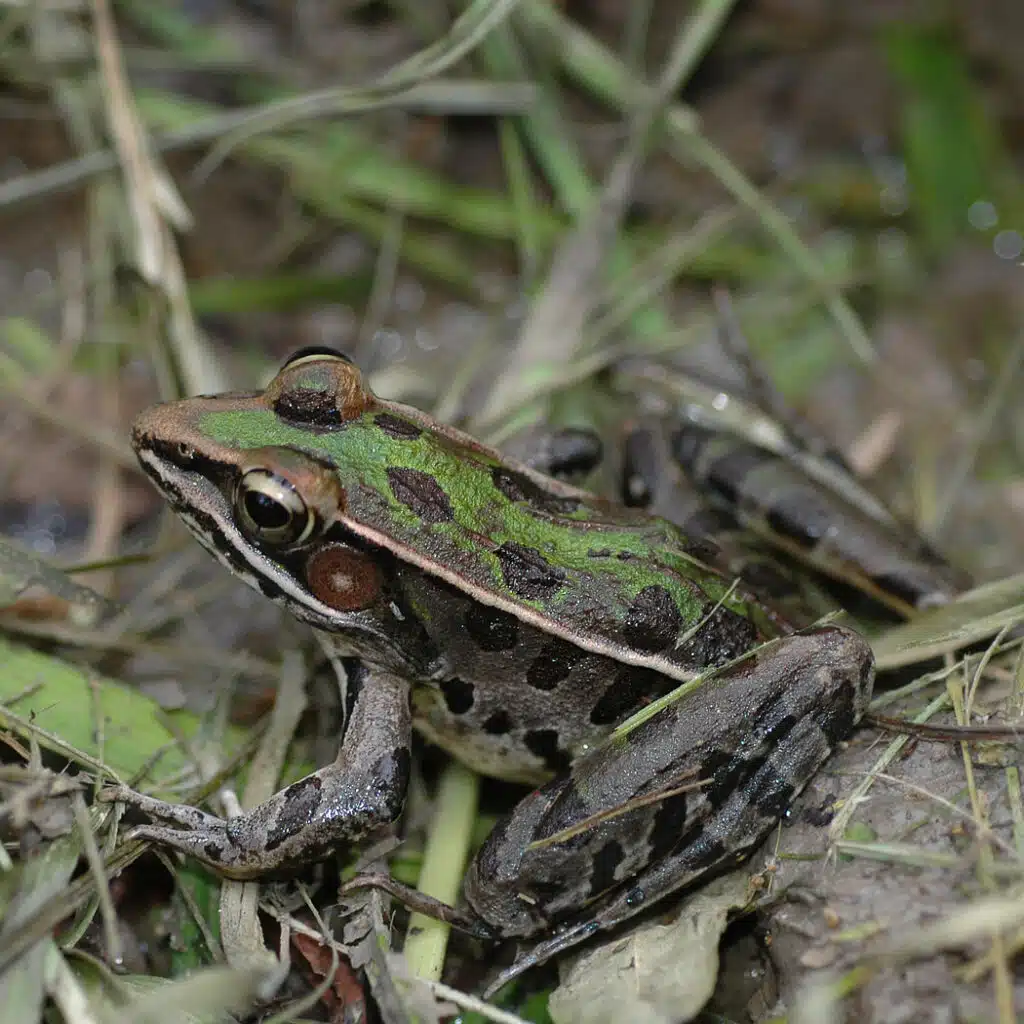
West Texas is a territory known for its high numbers of Southern Leopard Frogs (Lithobates sphenocephalus).
These types of large frogs have gray and green coloring.
Mid-dorsal sections of the frogs are mostly green with gray spots. The rest of the body is light gray with dark gray spots.
These types of frogs are found next to the water but they’re also among the rare types of frogs that also live miles away from water.
A common sight even on farms, abandoned crops, and mines, this species breeds multiple times per year, including in the winter.
A chuckling call is specific to the Southern Leopard Frog.
6. Rio Grande Leopard Frog
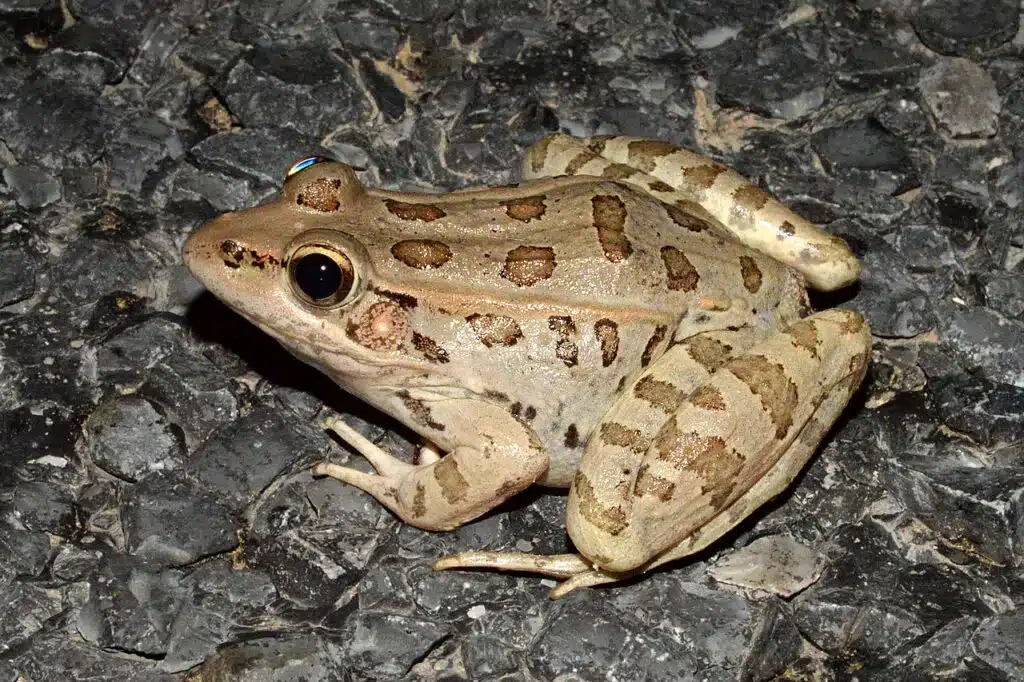
Also known as the Mexican Leopard Frog, the Rio Grande Leopard Frog (Lithobates berlandieri) has small to medium size.
It grows from 2 to 4.5 inches and it varies in coloring considerably. Gray, tan, and various shades of green are all specific to this species.
Rio Grande Leopard Frogs live close to the water in arid habitats.
They lay hundreds of eggs at a time and are known to prefer creeks and ponds for mating purposes.
Rio Grande Leopard Frogs come out during the day as the species is both diurnal and nocturnal.
The highest chance of spotting these frogs is during the day when it rains as they come out seeking high humidity.
Frogs of this genus largely eat insects with occasional meals including bugs and other smaller species that can swallow directly.
Unlike other types of frogs in Texas, Rio Grande Leopard Frogs make rattling noises.
7. Texas Toad
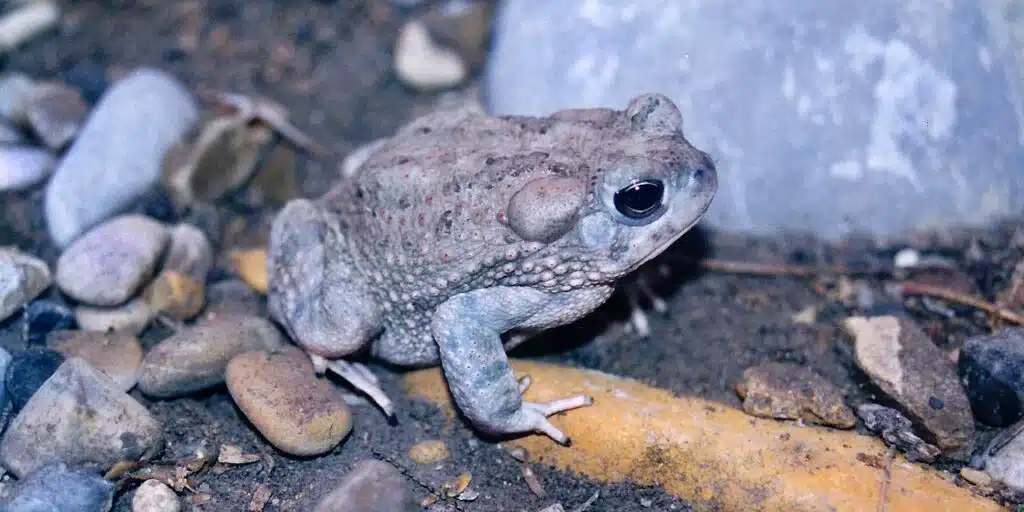
Texas Toads (Anaxyrus speciosus) are some of the most common species in the Southern US. This toad is native to Texas, where it holds a special status due to its high population.
Texas Toads are also present in Mexico in high numbers.
As with other species, Texas Toads are known for the mating call of the males.
Unlike other toads, the call or the noise these toads make is short and loud. It only lasts for about a second.
A short pause is made between these calls.
Males rely on the interpretation of their call when it comes to mating success.
The female Texas Toad only mates with the loudest and largest males.
You can find these types of toads around bodies of water, even in ditches or other temporary bodies of water in the state.
8. Squirrel Treefrog
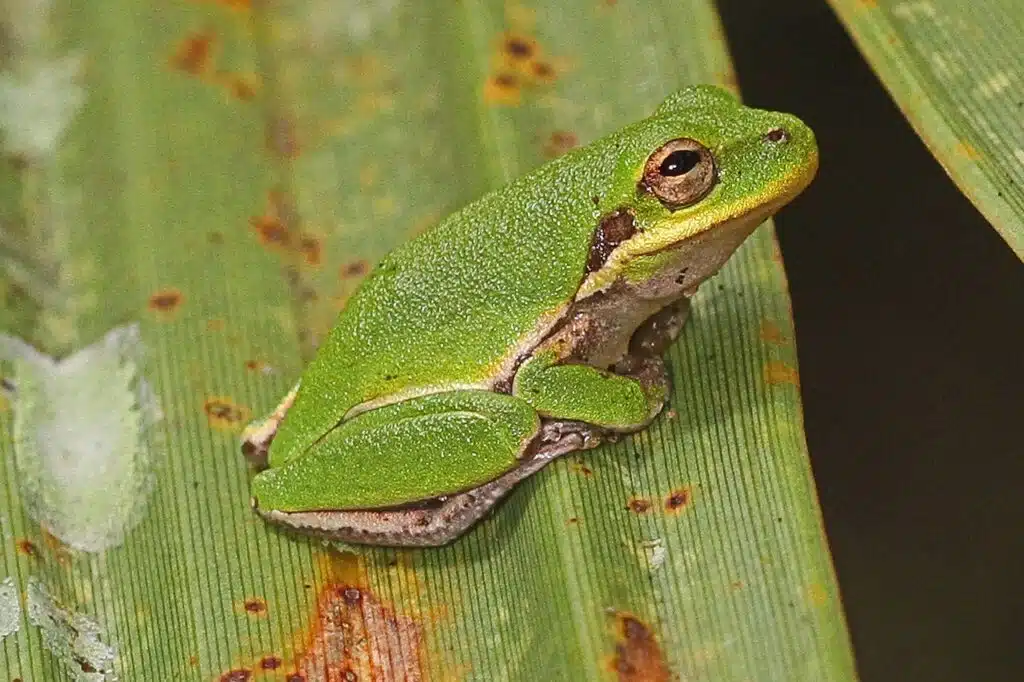
Squirrel Treefrogs (Hyla squirrel) are some of the most common species in Texas as well as a few other Southern states.
Correct identification of the species isn’t easy as Squirrel Treefrogs come in different colors and different patterns.
This is one of the smaller frogs in the state, often growing to a size of just an inch.
Squirrel Treefrogs have a green, brown, or gray color. Stripes may or may not be seen on their body, either between the eyes or on the sides.
Contrasting dorsal and ventral colors are specific to these frogs.
The dorsal color may be green or brown while the ventral color may be white.
A specific squirrel-like sound is made by these small frogs.
This type of sound is specific to males.
The species lives in moist habitats and may even be found in orchards and gardens with sufficient water or where watering habits are frequent.
9. Western Narrow-mouthed Toad
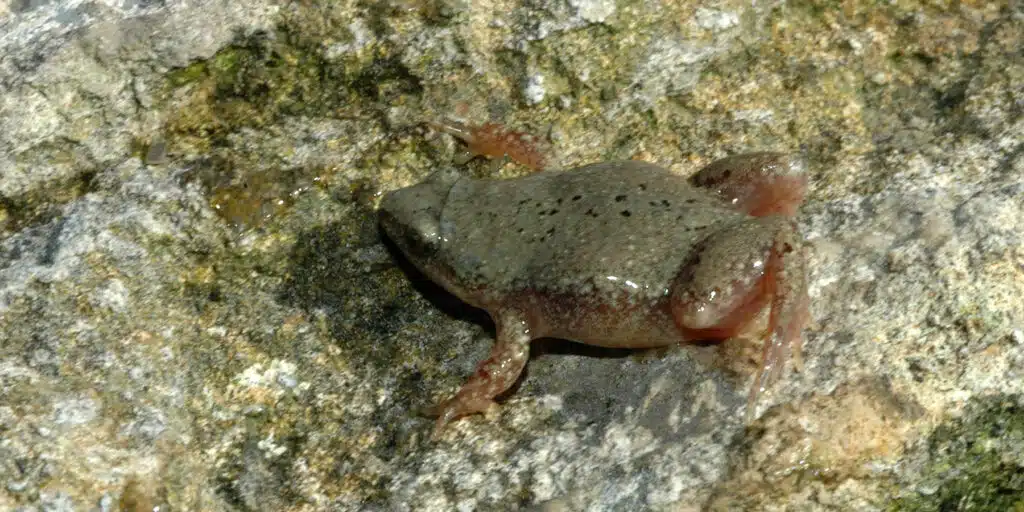
Western Narrow-mouthed Toads (Gastrophryne olivacea) have a dark olive-green color and a flattened body.
The species grows to a maximum size of 1.5 inches and it has a common nature in Southern Texas and Northern Mexico.
Toads of this family are found under logs, rocks, and other objects in moist areas.
This is where they get sufficient moisture and their best chances of finding their favorite insects, ants.
Handling these toads isn’t recommended.
Covered in allergic secretions, the toads can lead to burning sensations.
Western Narrow-mouthed secretions might even lead to irritated eyes as well.
10. Rio Grande Chirping Frog
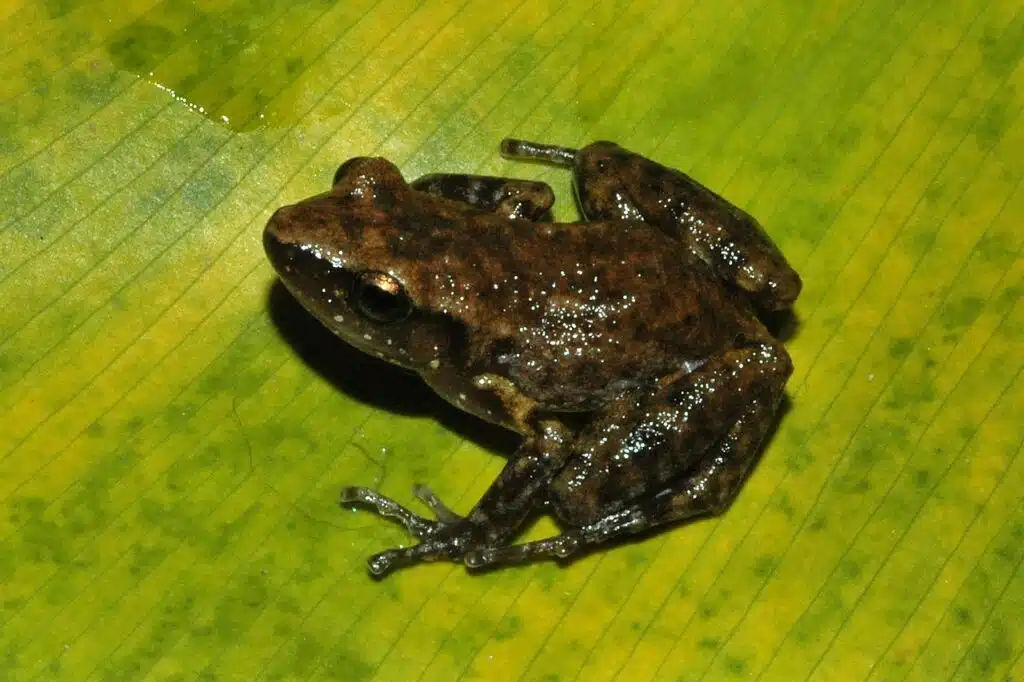
These types of frogs (Eleutherodactylus cystignathoides) are among the smaller common species in Texas. Males grow to a maximum size of 0.9 inches while females grow to 1 inch in size.
A high presence in urban environments is specific to this species which is both diurnal and nocturnal.
Both male and female Rio Grande Chirping Frogs are known to make calls.
Smaller females make more calls as opposed to larger females, probably to lure in more male mates.
The male makes rare calls as compared to other species.
While they don’t make as many calls as other species, male frogs are still known to be highly aggressive towards each other, mainly for mating rights.
11. Couch’s Spadefoot
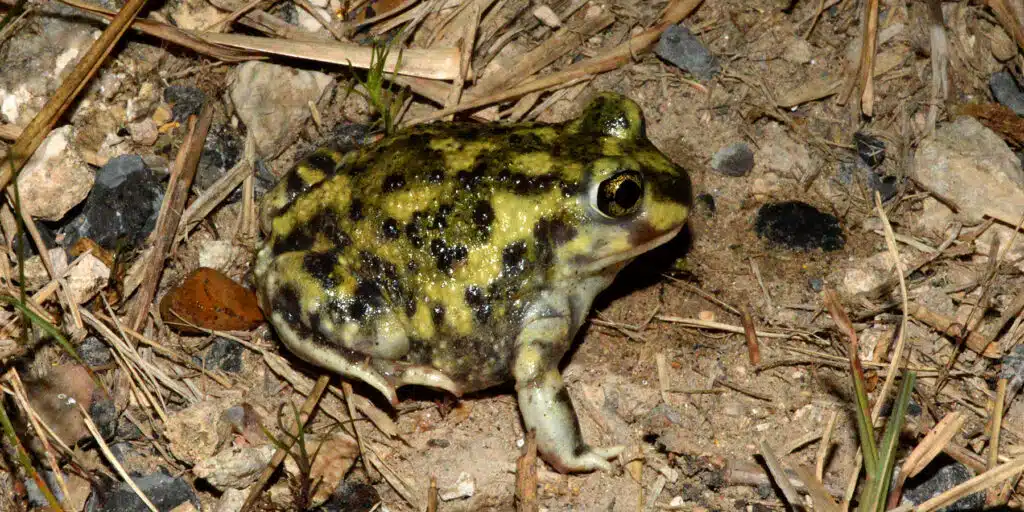
A common sight in Southern US territories, Couch’s Spadefoot (Scaphiopus couchii) is one of the species that has dark gray patterns on the body.
Small white verts are also seen in this species.
Hiding during the winter months, Couch’s Spadefoot is a species that comes out when it rains and during the summer months.
The species takes quick advantage of a rainy day as it begins mating after only one rainy day.
Calls are frequent in the species but female Couch’s Spadefoot has been known to select males based on coloring as well.
Brighter males are favored to a darker green and gray Couch’s Spadefoot males.
The emerged tadpoles of Couch’s Spadefoot like to eat all types of insects, even those that are dead, unlike the tadpoles of other species.
12. Woodhouse’s Toad
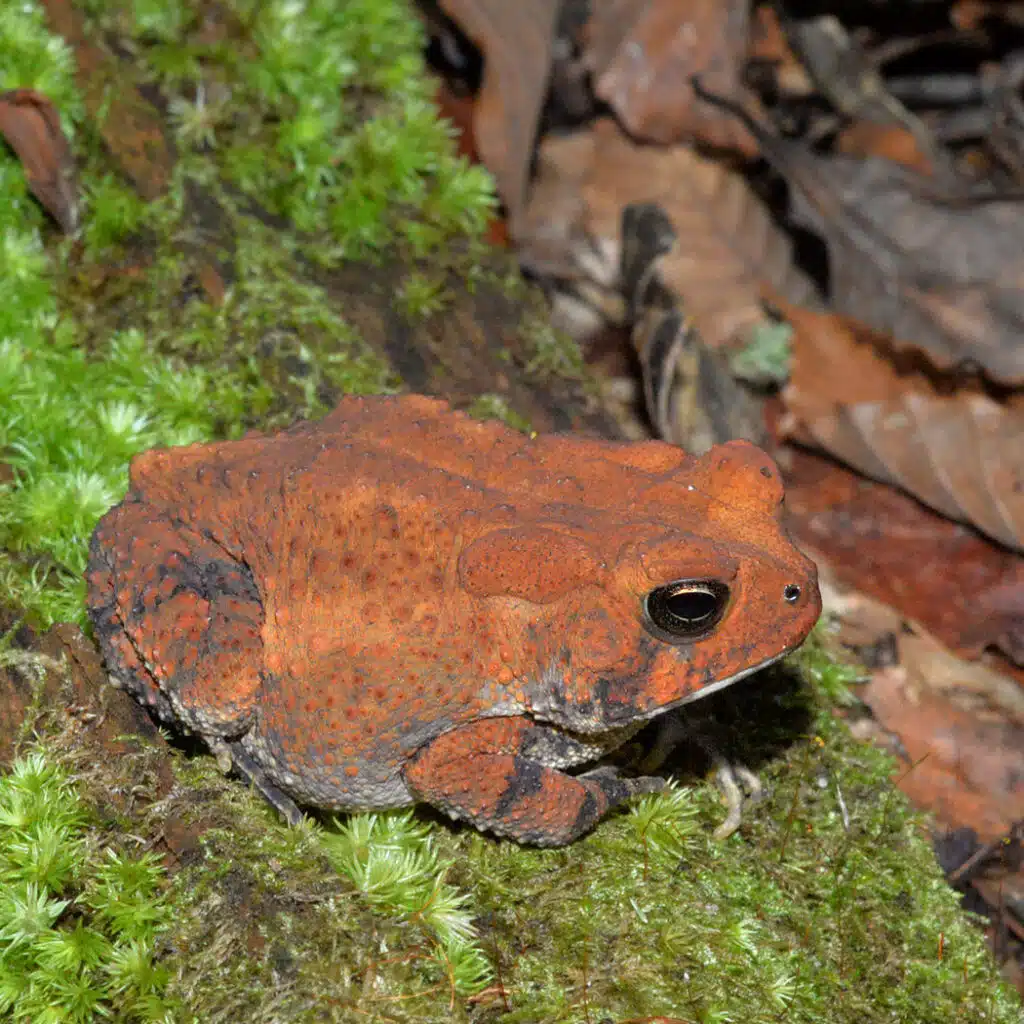
Gray-brown and yellow-brown colors are specific to Woodhouse’s Toad (Anaxyrus woodhousii).
This is a species that comes both in a patterned color and a pattern-free color. Various shades of brown dominate the morphs of this toad.
Most people identify the species by its calling sounds which resemble sheep bleat. This makes the species easily identifiable, especially since it lives in urban areas in ditches.
This species is attracted to light, as most types of toads follow insects which, in turn, follow lights at night.
Apart from small insects, it can also consume invertebrates.
Woodhouse’s Toads are considered resilient.
They can live both at low and high altitudes and aren’t as susceptible to habitat change reactions as other species.
13. Red-spotted Toad
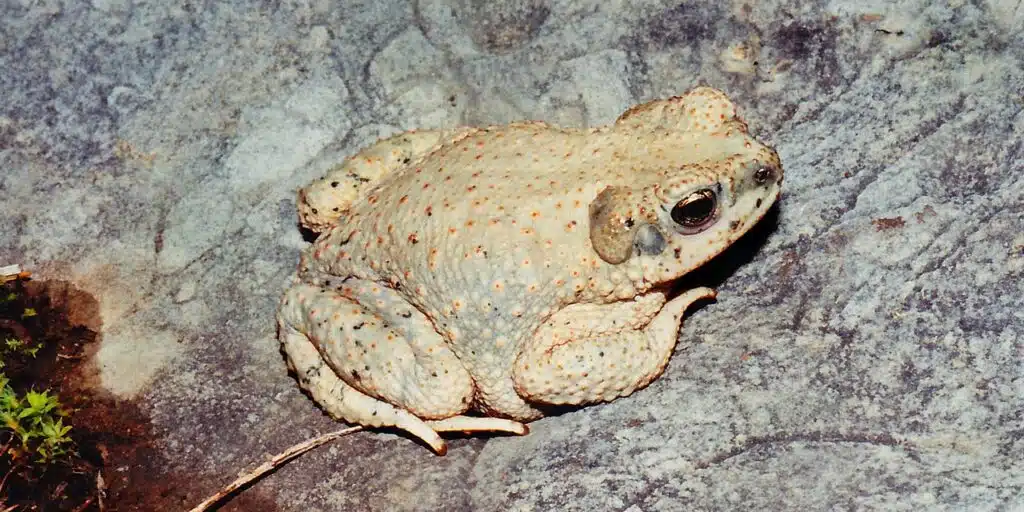
Red-spotted Toads (Anaxyrus punctatus) are found both in Texas and in other Southern states.
This species has different coloring, being one of the smaller toads in the state.
It grows to a maximum size between 1.5 and 3 inches and it comes in green, olive-green, and gray colors, with or without spots and stripes.
Red-spotted Toads are also known for coming in a morph with plenty of tiny red dorsal dots, which inspired its name.
These species live in humid areas around deserts and on arid rocky terrains where it camouflages themselves between rocks.
This species spends most of its time under rocks or hiding and it only comes out when it rains.
It mates immediately after rain accumulation and puddle formation.
14. Gray Treefrog
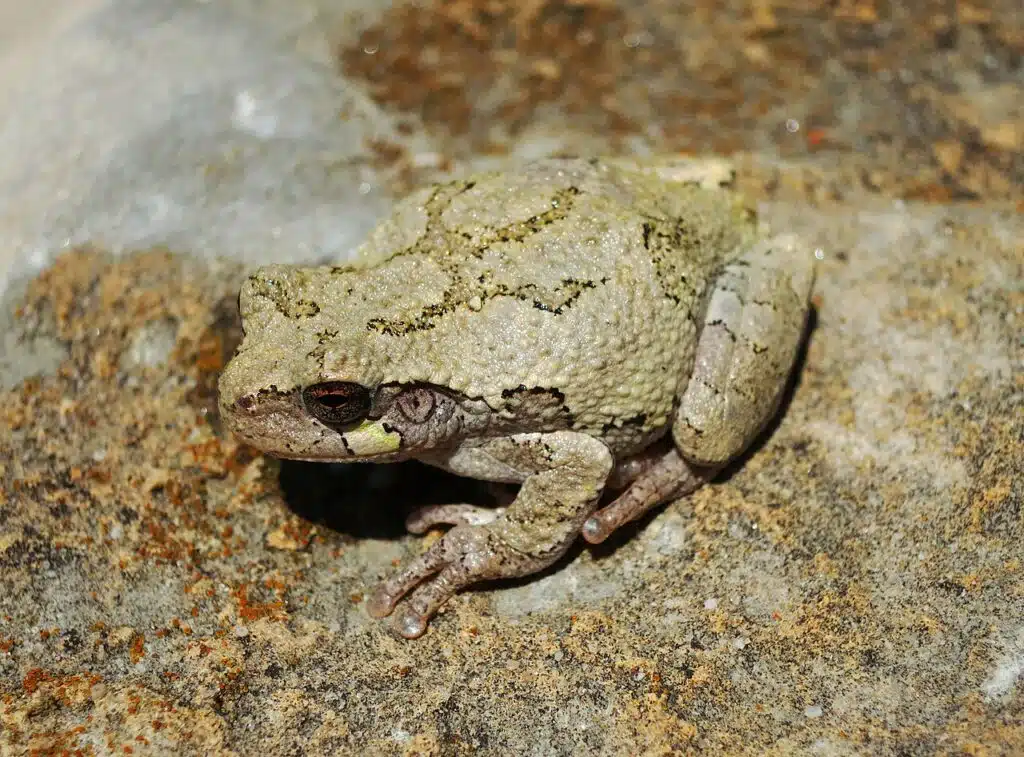
Gray Treefrogs (Hyla versicolor) are highly arboreal. These species of frogs are known for quick adaptation to their environment when it comes to coloring.
A high diversity of colors and patterns is specific to these frogs.
Those living on trees take on gray and dark gray colors. Frogs living on lower vegetation are often green and not patterned.
Safe to handle, the species is only aggressive with other frogs. Male-to-male aggression is specific whenever these frogs are seen calling in choruses.
A solitary species, The Gray Treefrog is among the frogs that only get together to call for females.
Males show aggression towards other males calling nearby as females are unable to locate the exact source of the call in this scenario.
Ants, grasshoppers, and all types of beetles living in Western Texas are part of the frog’s diet.
15. Cope’s Gray Treefrog
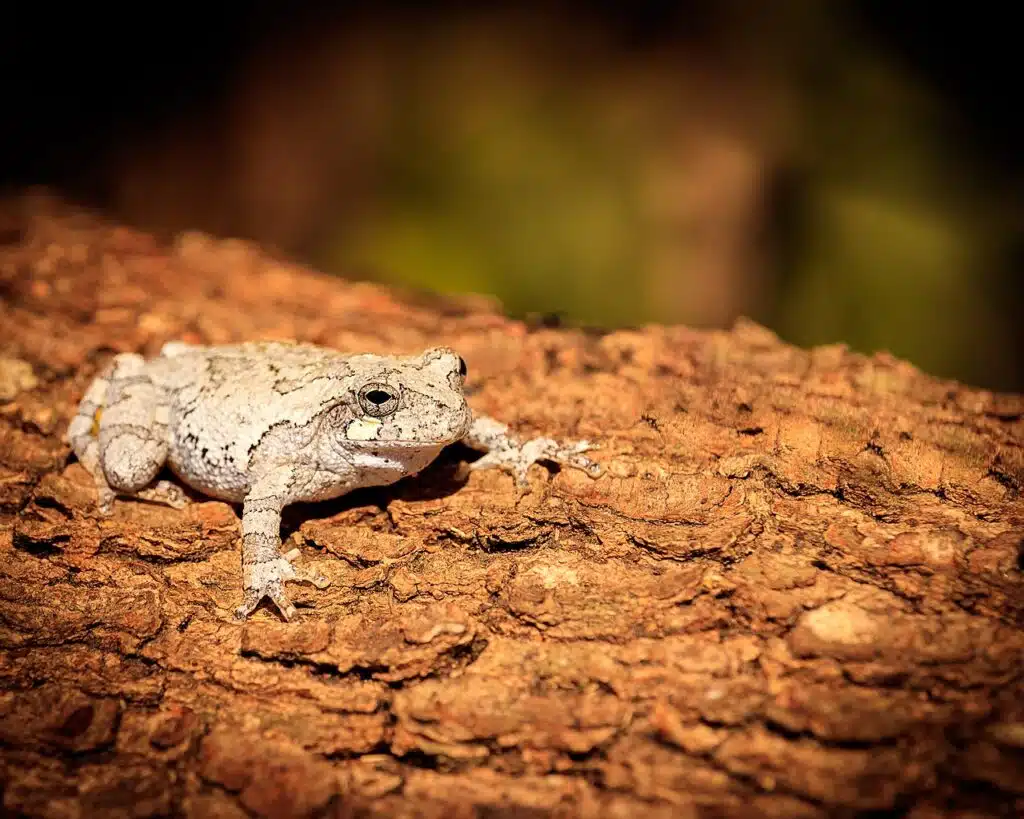
This type of treefrog (Hyla chrysoscelis) is also known for coming in various colors and patterns.
Green, gray, and patterned coloring is specific to Cope’s Gray Treefrogs.
Handling this species is not recommended as this leads to irritation. Both skin and breathing can suffer from the secretions of this frog.
These frogs are known to live in woodlands but they can deal with drier habitats compared to other species.
Living solitary lives, males rely on calls to lure in females. These calls are among the loudest compared to other frogs.
Noise levels measurements often show calling choruses of these frogs to reach 90db, a noise level comparable to that of a running motorcycle.
Females are potentially attracted to the loudest calls, clearly differentiating lower volume calls.
16. Eastern Narrow-mouthed Toad
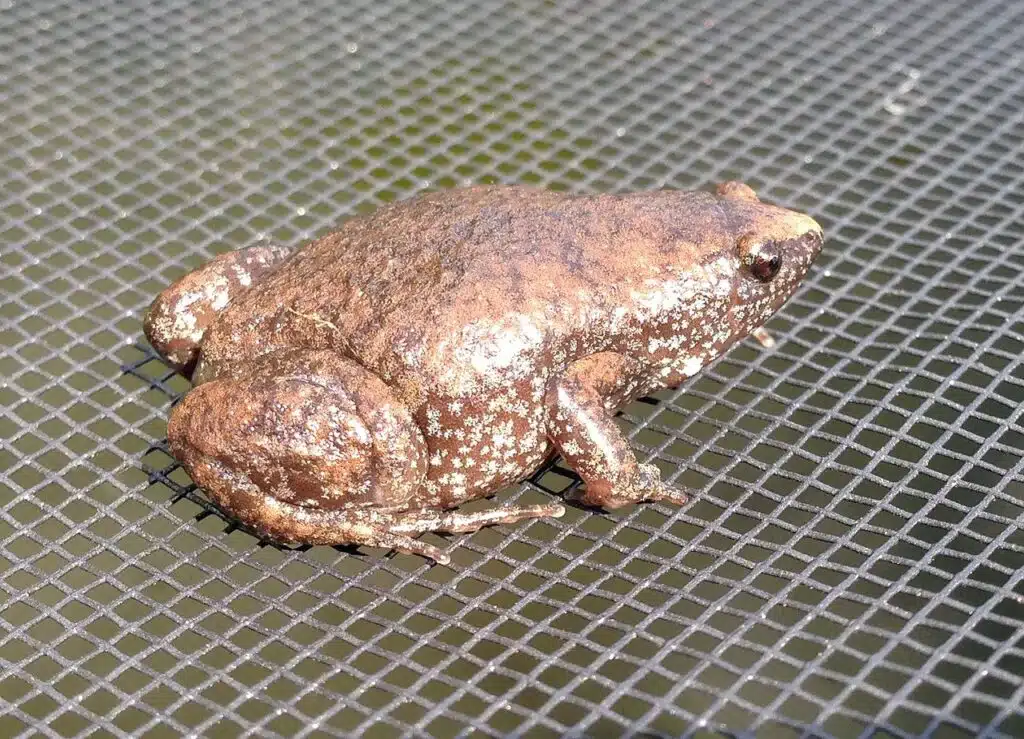
Eastern Narrow-mouthed Toads (Gastrophryne carolinensis) grow up to a size of 2.1 inches.
Different types of colors are specific to the species.
Gray and brown colors are mostly encountered on these toads. Even these colors can show nuance changes depending on the activity of the species.
Eastern Narrow-mouthed Toads have water-free skin.
High-pitched sounds are specific to this species. Eastern Narrow-mounted Toad calls are also based on a buzzing tone which makes them sound different from other species.
These sounds last at least a second.
Reproduction occurs in permanent or temporary bodies of water with plenty of vegetation.
Up to 40 eggs are laid by the female in these shallow bodies of water soon after mating.
17. Cliff Chirping Frog
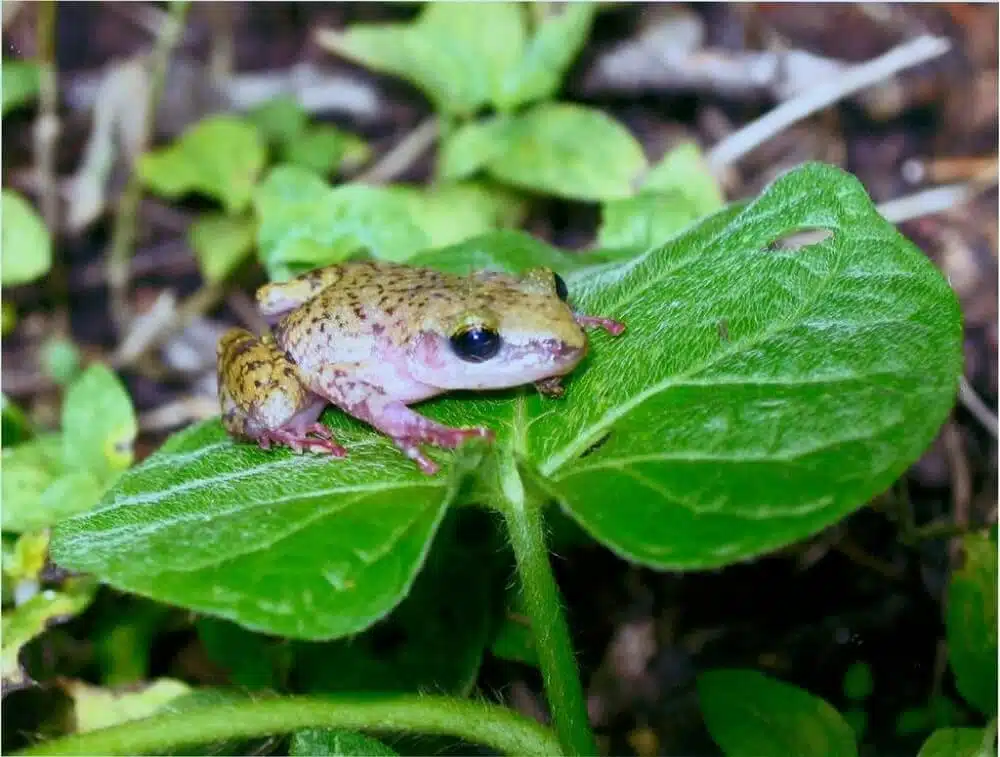
Green and black colors are specific to this species (Eleutherodactylus marnockii). Olive-green coloring of a bright nuance is characteristic of the Cliff Chirping Frog.
This color is chosen to camouflage itself in certain areas such as limestone formations.
Some Cliff Chirping Frogs are also known for having a base black color with olive-green patterns across their dorsal side.
Having short feet, the frog can jump and crawl.
Mating occurs multiple times per year. 2 to 3 Cliff Chirping Frog broods are specific per year.
Females of the species lay eggs either directly in the ground or under rocks. Only moist ground is chosen as a dedicated egg-laying spot.
18. Green Frog
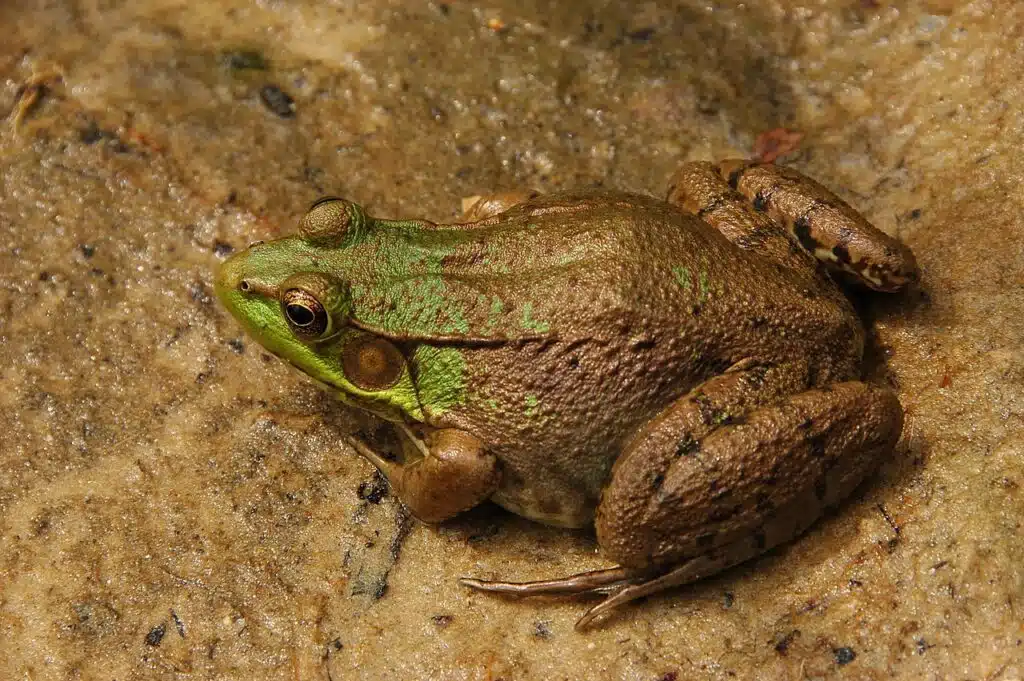
Green Frogs (Lithobates clamitans) are named after their base green dorsal color. The lighter green coloring is specific to the snout area.
This is a species that grows to a maximum size of 3.9 inches.
Green frogs are highly territorial, especially in the case of males. They establish a territory that they guard until the mating season.
Females aren’t impressed by the territorial claims of males but by the loudness of their calls. They only mate with the loudest males.
Female Green Frogs are among the species that can lay thousands of eggs at a time.
The feeding habits of the species are diverse and opportunistic.
They can eat almost any type of insect or invertebrate they can swallow.
Spiders, flies, and other small frogs are often consumed by Green Frogs.
19. Spotted Chorus Frog
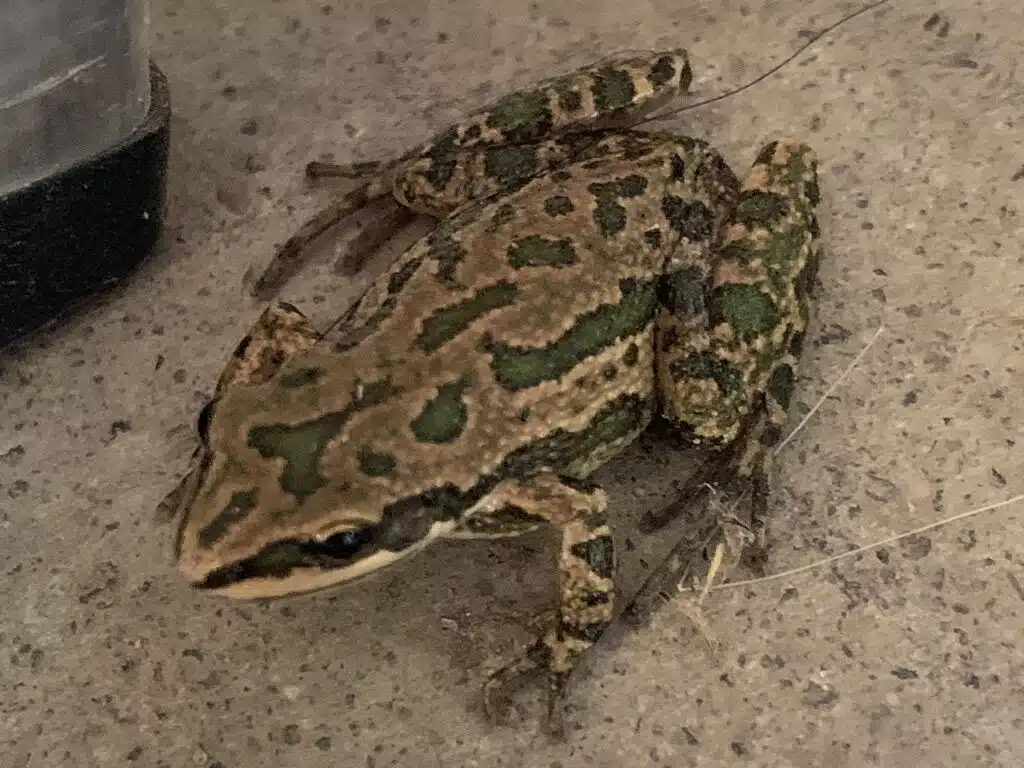
Spotted Chorus Frogs (Pseudacris clarkii) are a species known for having various nuances of green.
A light green morph with dark green patterns is the most common for the species, together with a brown morph as well.
Spotted Chorus Frogs are also some of the smallest in Texas.
Females, larger than males, grow up to a size of 1.2 inches.
Both males and females can be seen in ditches and temporary or permanent bodies of water. Mating is based on the most humid locations as eggs are laid directly in the water.
Male Spotted Chorus Frogs are known to reach sexual maturity sooner than females.
Spotter Chorus Frogs are known for having loud and slow calls, compared to other species.
Seen on vegetation around water relaxing during the day, this species becomes active at night.
20. Fowler’s Toad
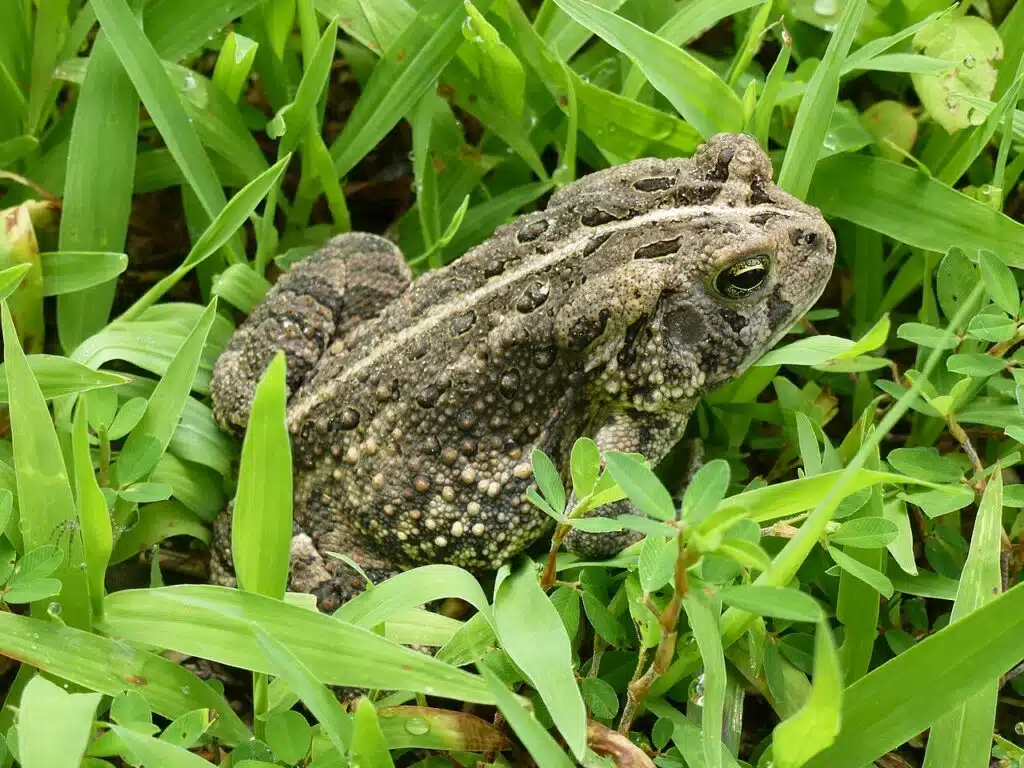
Fowler’s Toads (Anaxyrus fowleri) are a common species in the state in their green color or its rarer brown morph.
This species is known for having a small to medium size, growing to a maximum of 3.7 inches.
Flower’s Toads are widespread around Southern US, including much of Texas.
A rare sight during the day, this species might only be easy to spot in the evening, particularly in the rain.
Female Fowler’s Toads are some of the most productive species in the state.
More than 20.000 eggs can be laid by a single female in 1-3 yearly broods.
It also takes up to 3 years for females to reach maturity.
This species can be further distinguished by its clear calls. These calls resemble sheep bleats.
A secure species in Texas, Fowler’s Toad has an almost extinct status in other states such as Florida.
21. Canyon Tree Frog
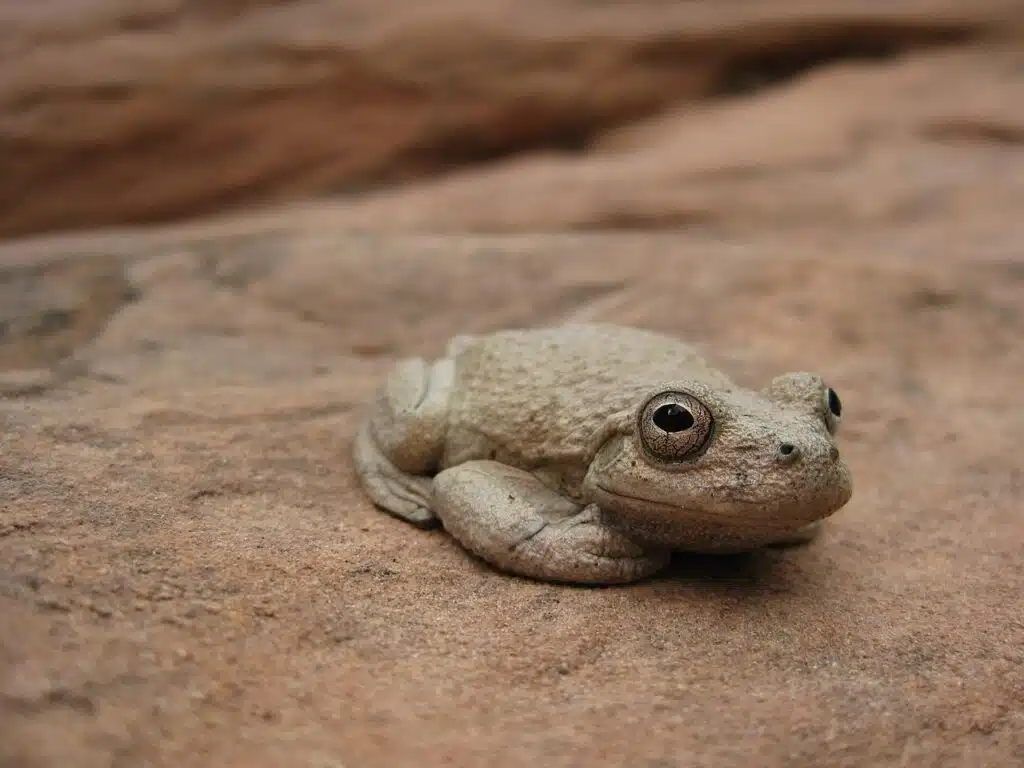
Canyon Tree Frogs (Hyla arenicolor) are a typical nocturnal and carnivorous species in Texas.
These types of frogs take on the color of the environment.
Green and gray colors are common in the species. Blotches, often of a darker gray or darker green nuance are also spotted on the species, on occasion.
A bright color is one of the main characteristics of the Canyon Tree Frogs through the species’ rocky terrain habitat.
It has a bright color as it spends most of its time on limestone.
In rare granite habitats, this species can have a gray-pink color with or without darker pink blotches.
Females Canyon Tree Frogs lay eggs directly in water.
Unlike many other species in Texas, female Canyon Tree Frogs only lay up to 100 eggs per season.
22. Hurter’s Spadefoot
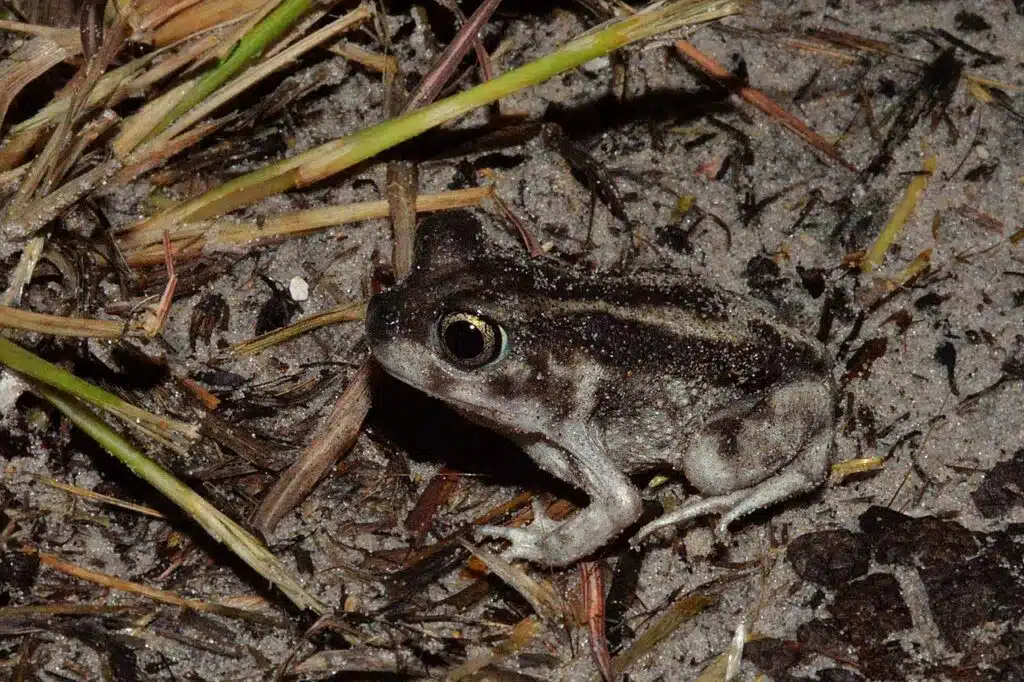
Hurter’s Spadefoot (Scaphiopus hurterii) is one of the Texas species with a body covered in warts. The species sends potentially-poisonous status to its predators through its uneven skin.
Green, dark green, and green-to-black colors are specific to Hurter’s Spadefoot. This is a species that has yellow to white ventral coloring.
Hurter’s Spadefoot has large eyes on the top of the head with vertical pupils.
This species is never seen during the cooler months as it hides underground.
It can be seen coming out on sandy terrains around woodlands in the summer.
Mesquite scrub is one of the few areas Hurter’s Spadefoot can survive in arid Texas conditions.
23. Giant Toad
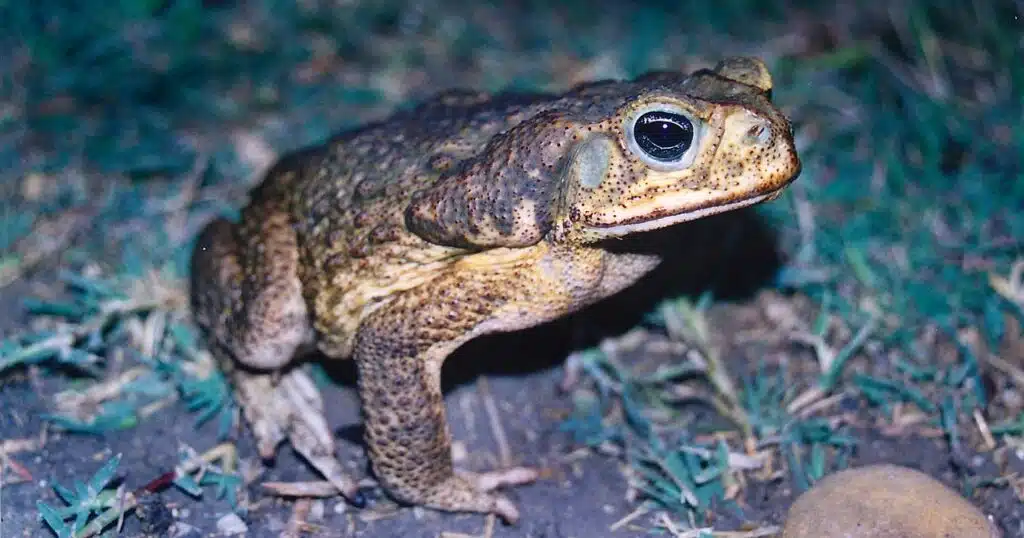
Giant Toads (Rhinella horribilis) are some of the largest Texas species. Green color with gray undertones and brown to black blotches is most specific to the toad.
Giant Toads lay eggs directly in water. These eggs are often connected and they’re always anchored in an area with steady water.
Giant Toads are among the species that can consume a wide range of insects and invertebrates.
The species can even eat venomous species and some of the most painful sting wasps.
Larger body size also allows Giant Toads to eat many other species.
Some of these include other types of frogs and lizards, albeit to a lesser extent compared to bugs and insects.
24. Plains Leopard Frog
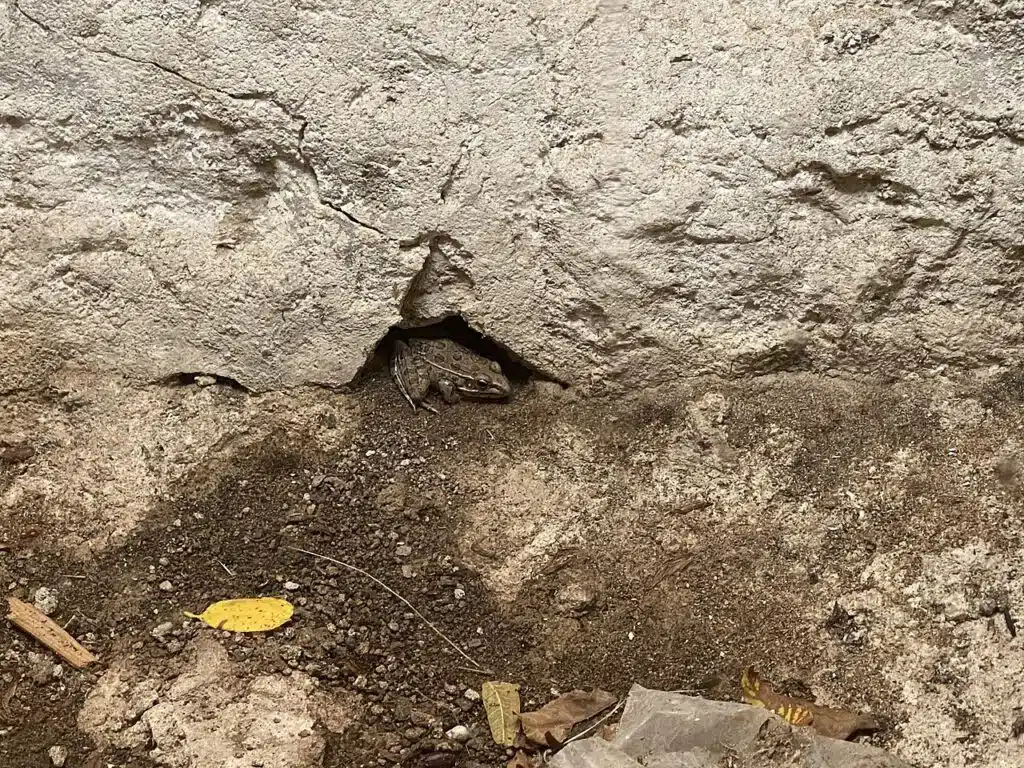
Mostly green and sometimes green-brown, the Plains Leopard Frog (Lithobates blairi) grows to a size of up to 4 inches, with many individuals measuring less than 3 inches.
This is a common species around permanent bodies of water such as marshes.
It takes on the coloring of its natural habitat.
Plains Leopard Frogs have a dark color with black spots and bright lateral stripes which look similar to dry vegetation in their natural habitat.
Eating habits are diverse, as with most frogs. It can eat almost anything it can overpower.
The species has stable populations in many areas of Texas and an endangered status elsewhere.
Heavy use of chemicals on crops is one of the main reasons Plains Leopard Frogs start to decline in numbers across the Southern United States.
The status of this species is secure in Texas where no special methods are taken to save the species.
25. Chihuahuan Green Toad
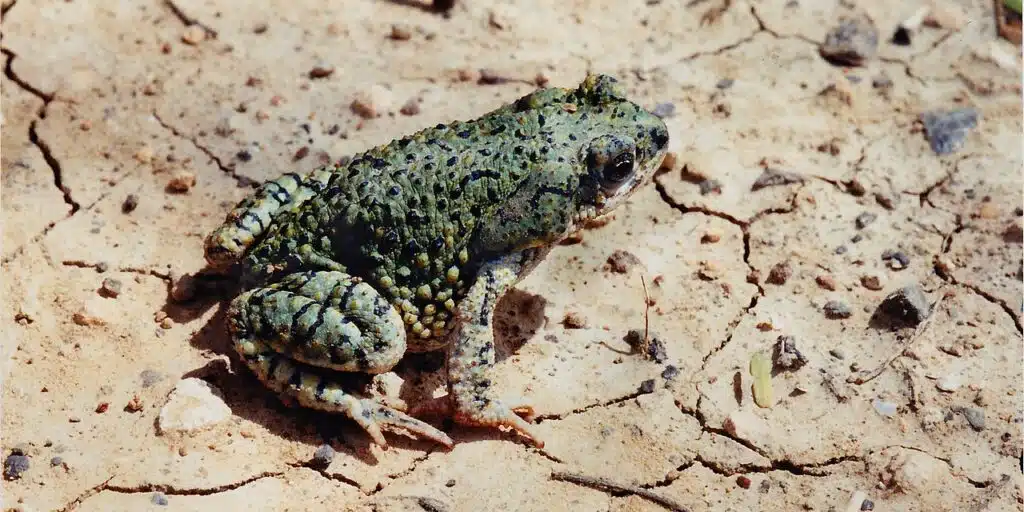
Simply known as The Green Toad, this species (Anaxyrus debilis) has a light green base color.
Chihuahuan Greeen Toads are similar to European Green Toads.
It rarely comes in uniform green coloring, often showing black spots across its dorsal side.
Yellow spots are sometimes seen on the dorsal side of the Chihuahuan Green Toad.
The legs of the species are either tan or cream with black blotches.
Toads of this genus are further known for their arid terrain preferences. Only living in dry conditions, Chihuahuan Green Toads have mostly seen after it rains.
It takes 1-2 days for the species to mate soon after it rains.
Male toads form choruses in areas with puddling water where they attract females for mating.
This terrestrial species is adapted to living in adverse conditions across Texas and Mexico.
26. Great Plains Toad
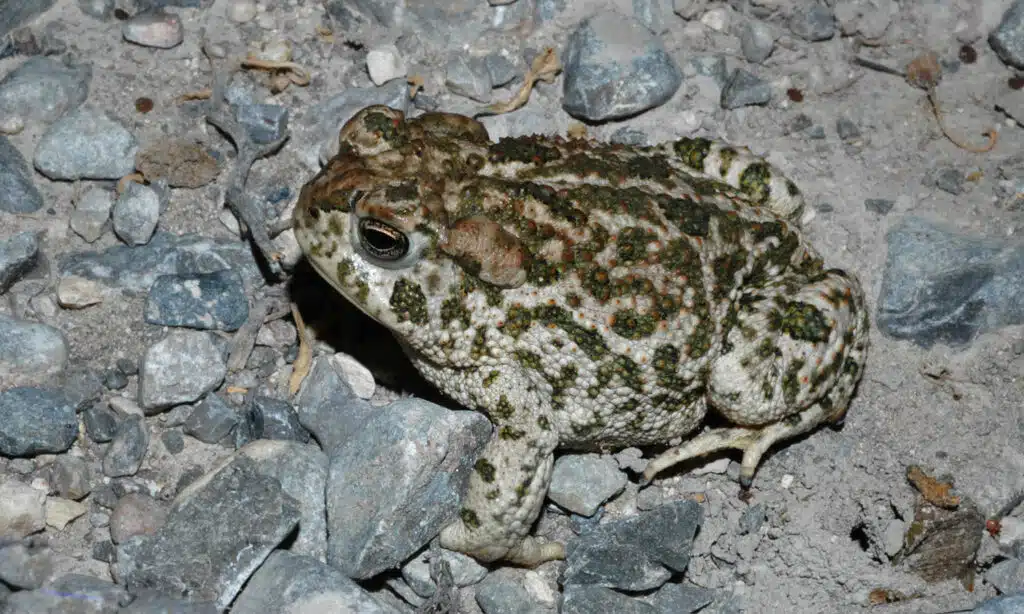
Great Plains Toads (Anaxyrus cognatus) have a widespread distribution across the state.
This species feels most comfortable in lowland prairies and highland prairies, not necessarily its ideal habitat in Texas.
It also lives next to canals, reservoirs, crops, and other sources of water.
Green, gray, and brown colors are specific to this species. Growing to a maximum size of 4.3 inches, Great Plain Toads are very active in the spring.
This is the ideal mating time for the species.
Various types of spiders and beetles are among the prey it relies on daily. Since it also lives in desert scrub, this species also consumes ants.
Great Plains Toads have many predators themselves. While not a threatened species, these toads are often eaten by various snakes.
A common species in temporary bodies of water, these toads come out soon after it rains to mate.
Their laid eggs take anywhere between 3 to 5 weeks to hatch.
Excessive urbanization is one of the main reasons why this species retreats further West to The Sonoran Desert.
27. Strecker’s Chorus Frog
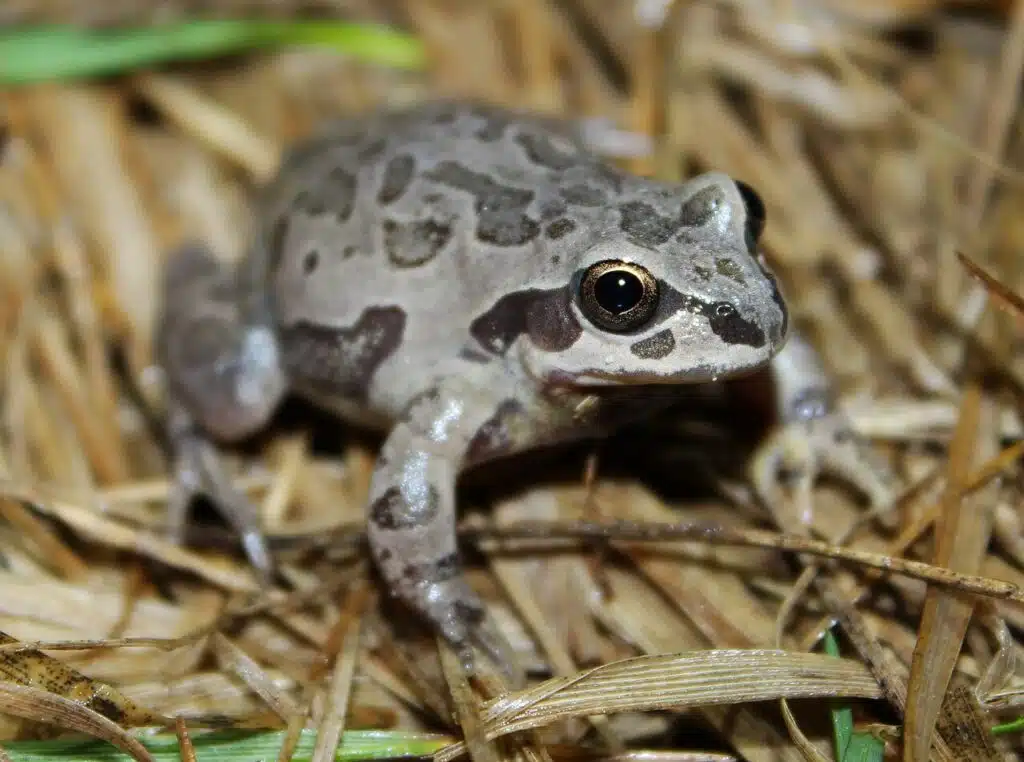
This species (Pseudacris streckeri) also comes in various colors. It has green, gray, and brown coloring, depending on its environment.
Strecker’s Chorus Frogs are known for making some of the most unusual calls which resemble whistles.
The species likes to live in arid areas where it spends most of its life underground, buried under sand or loose soil.
This helps protect it from dry air and predators.
Strecker’s Chorus Frogs come out when it rains, mainly to mate. They end up making calling noises in groups known as choruses, which only inspire the name of the species.
This fossorial species returns underground after mating. Only its head may stick out of the sand as it spends much of its days buried in the sand.
You can find this species next to all types of water sources and under dense vegetation protected by an underground water source.
28. Cajun Chorus Frog
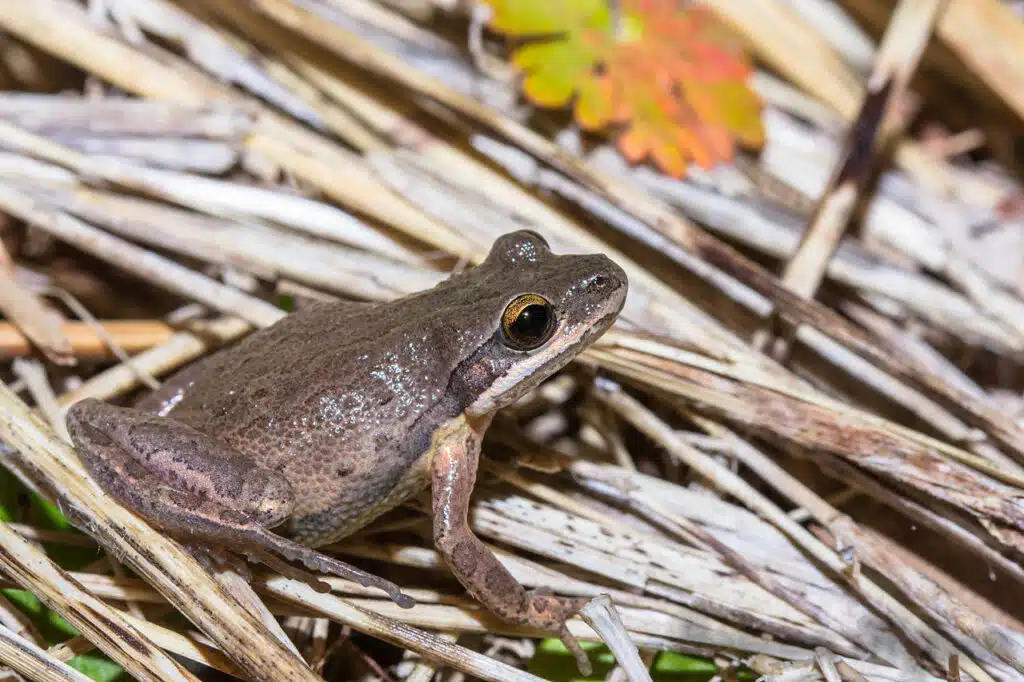
Cajun Chorus Frogs (Pseudacris fouquettei) are known for their brown color. This species also shows dark brown patterns across its dorsal side.
Some Cajun Chorus Frogs can be identified by their irregular dark brown stripes on the dorsal side. This gives the species a striped appearance.
However, the dark brown stripes of the species are only easily visible on the light brown Cajun Chorus Frogs.
There’s little coloring variation in the species that doesn’t come in a green form.
Found across Texas, Cajun Chorus Frogs are also native to other Southern states and Mexico.
29. American Toad
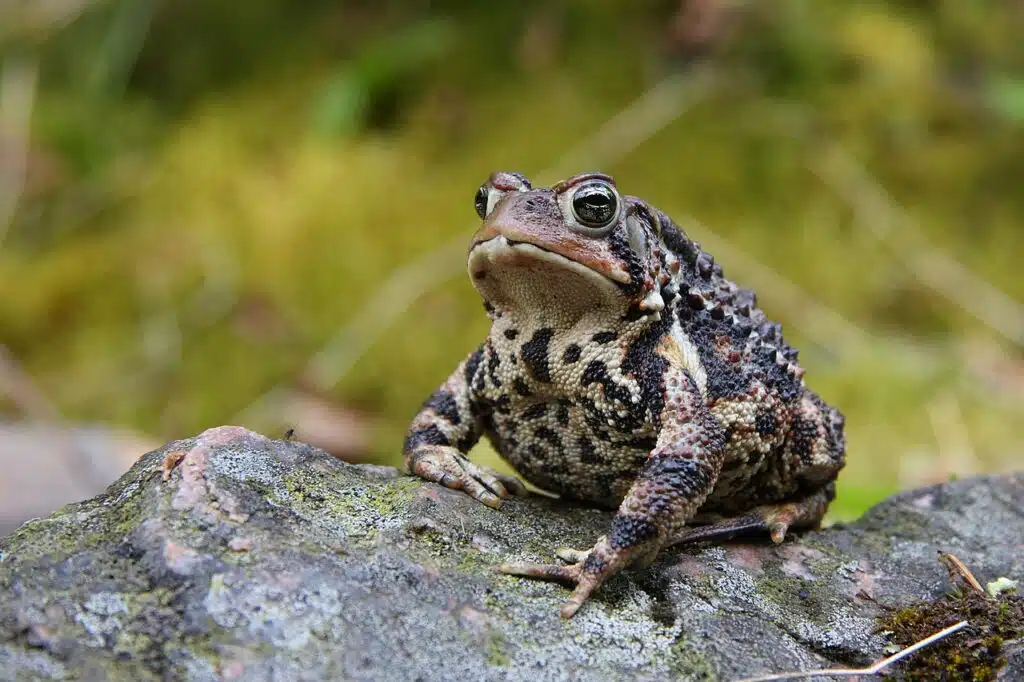
Brown, gray, or green, American Toads (Anaxyrus americanus) are a common sight throughout much of North America and Texas.
This species is further divided into 3-subspecies capable of taking the coloring of the environment.
Green and brown coloring is highly common on American Toads. These types of toads are also covered in warts.
American Toads use certain types of chemicals toxic to the skin of humans and animals to protect themselves.
These are species thoroughly studied for mating behavior.
American Toads always return to their native sights for mating. This is where many toads are found soon after it rains.
Inbreeding is possible given there’s always a high number of toads in a given area.
However, female American Toads are generally able to identify other related male toads by the calling tonality.
30. Mexican Spadefoot
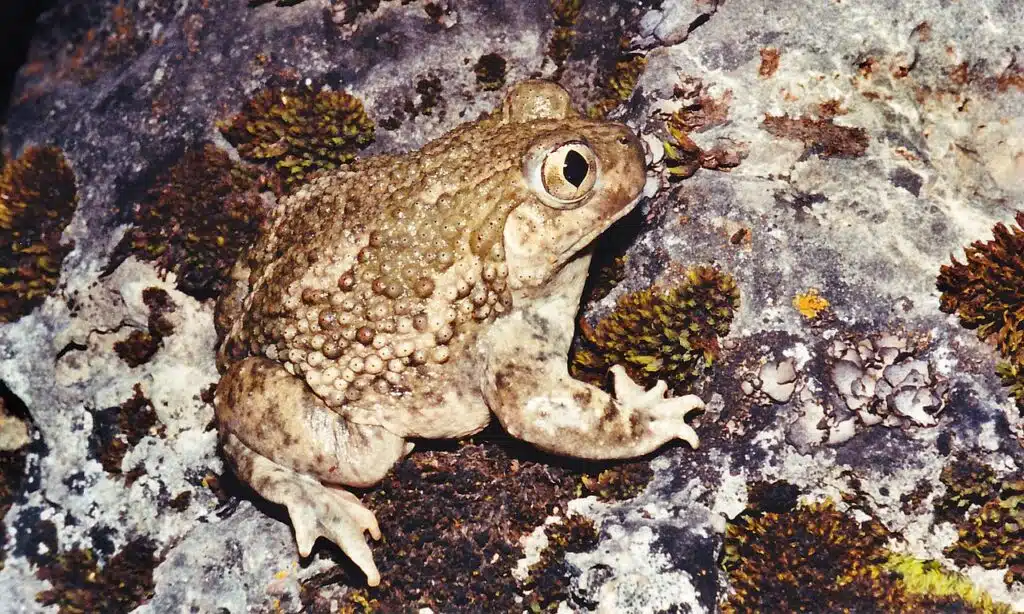
Mexican Spadefoot toads (Spea multiplicata) are named after the shape of their hind legs which allows the species to dig into the soil.
Native to Mexico, the species has also made it to Texas and other states such as New Mexico.
This is a bright type of toad, common in a light gray color. Green and brown morphs of the species might also be seen in the state.
Only coming out for food or to mate, this is a species known for a rapid egg-hatching time.
Females lay eggs in shallow water with vegetation. These eggs may hatch in 1-2 days.
Mexican Spadefoot toads eat various types of insects.
These toads are small, only growing up to a size of 1 to 2.5 inches which limits the insects they can consume.
31. Plains Spadefoot
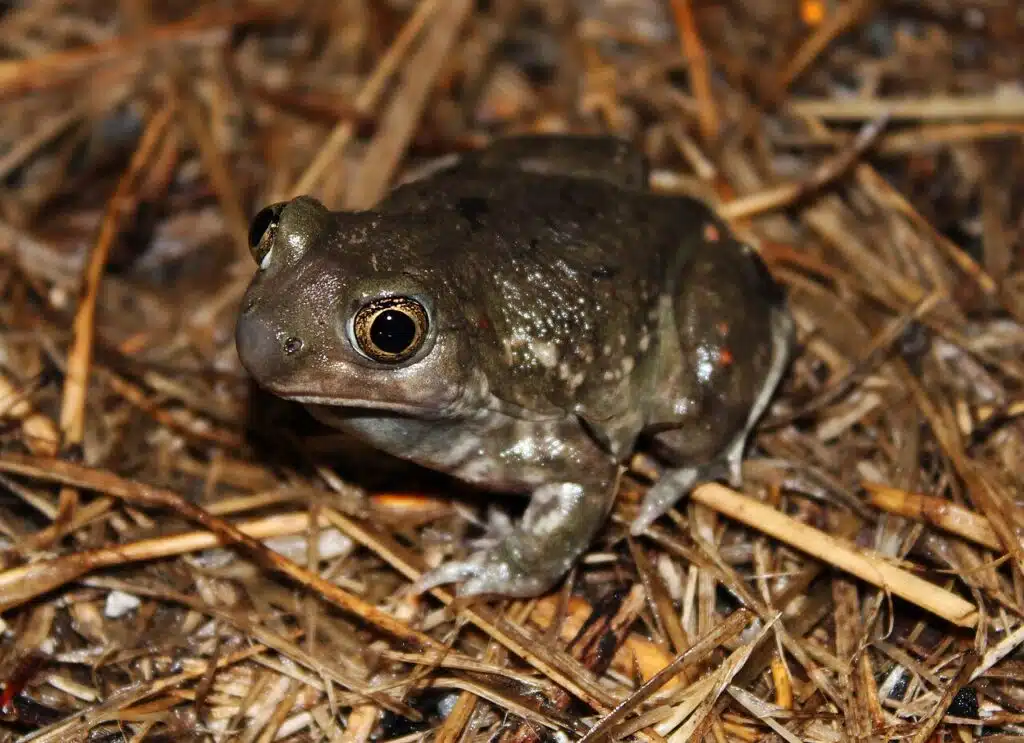
Plains Spadefoot toads (Spea bombifrons) are among the colorful species in Texas.
These toads often have a green color with black and orange dorsal patterns. Orange patterns are often seen in the shape of dots or marks.
Plains Spadefoot toads are nocturnal. They live in the ground and they don’t need to come out as they absorb water instead of drinking water.
These types of toads are solitary and not very aggressive toward each other.
The mating season marks the only occasion where mild aggression levels are seen between males.
These types of toads use specific areas for mating. They rely on sensory cues to identify the water sources that are best for laying eggs.
One of the first aspects that dictate an ideal egg-laying spot for Plains Spadefoot females is the potential presence of predators in a habitat.
Poor swimmers, these types of toads are often found in the same area they hibernate as they cannot travel far.
32. Sheep Frog
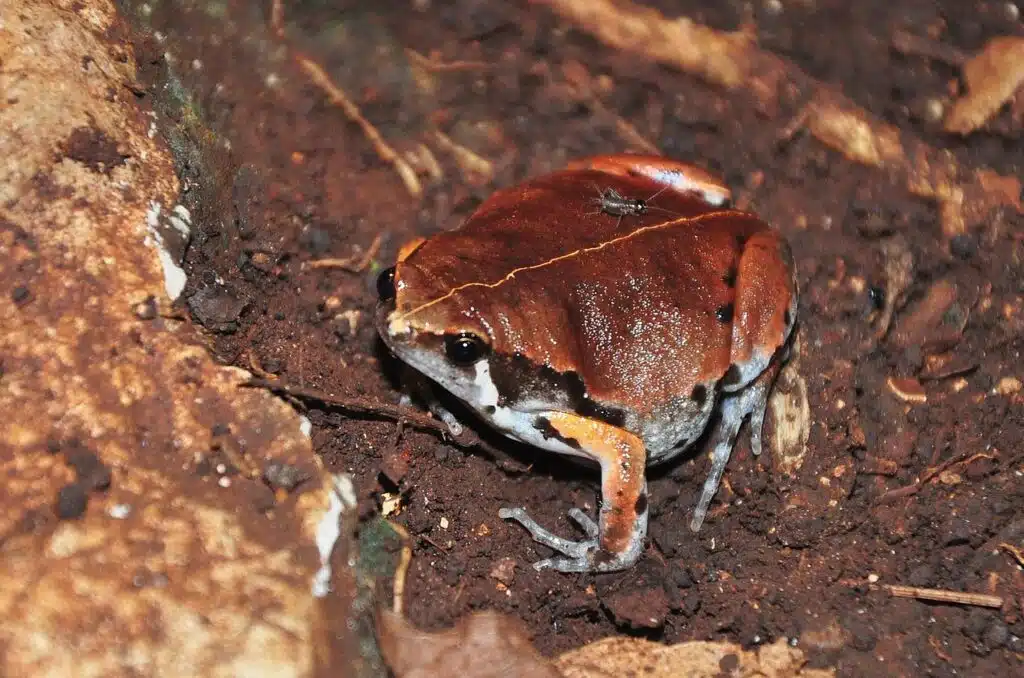
Sheep Frogs (Hypopachus various) are a threatened species in Texas. This species gets its name from the sound of its call which resembles sheep bleat.
Various shades of brown are specific to this species.
Sheep Frogs have a light brown color and may show a central dorsal stripe. This stripe can be dark brown or black.
In some cases, the stripe can be absent while other frogs of the species might only show a mini stripe.
The rare sightings of the species might be tied to its specialized feeding.
This is not a species that feeds opportunistically. It may have a positive role in the ecosystem by feeding on termites.
It also consumes ants, as a secondary choice.
Frogs of this family may survive on irrigated crops.
Heavy industrialization and urbanization lead to a diminishing natural habitat for a species that shows low levels of adaptability.
33. Spring Peeper
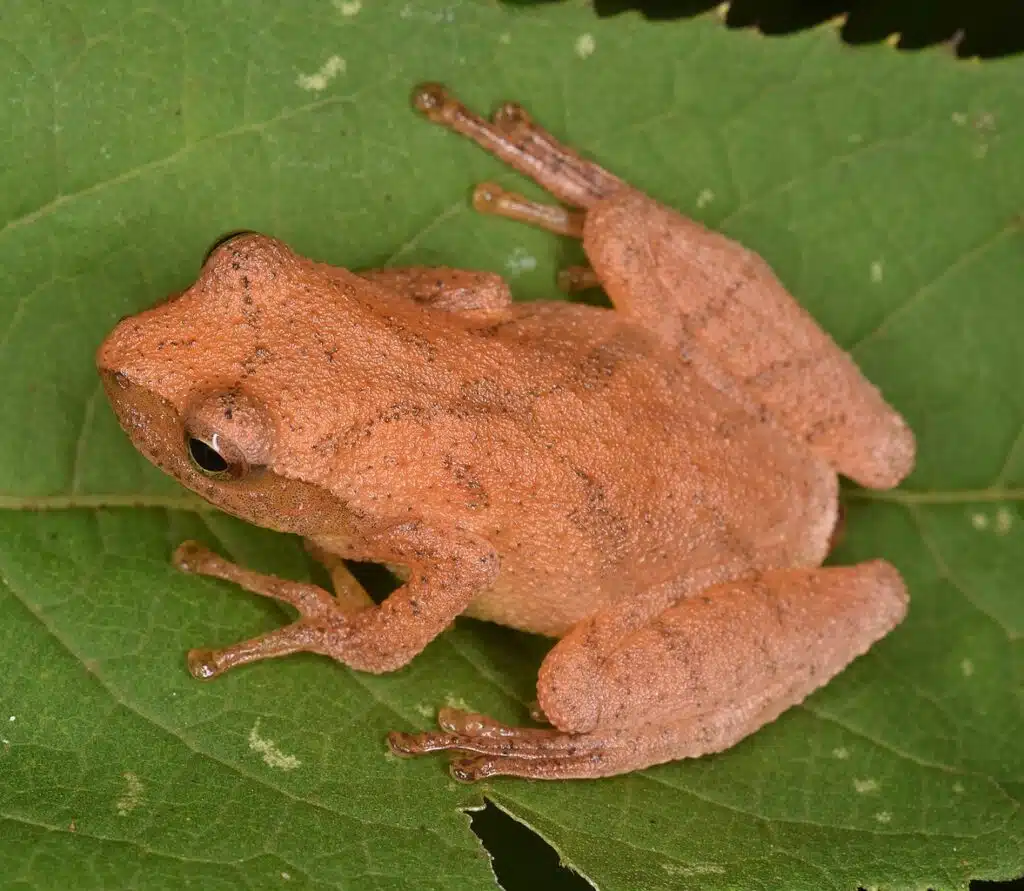
Spring Peeper frogs (Pseudacris crucifer) are among the species found in Eastern parts of Texas.
This is a small species that barely grow to a size larger than 1.5 inches. Apart from sizing differences, there are coloring differences between Spring Peepers as well.
Frogs of this family are known to have brighter females.
They come in the same tan, green, and olive colors as the males, but in brighter nuances with marks on the back.
Dorsal cross-shaped patterns across the Spring Peeper have led to many calling these frogs cross-bearing.
The species climb on trees with adapted legs.
Spring Peepers are known to be some of the first frogs to appear in the spring, as their name suggests.
The species can be identified by its distinct peeping call which only males can make.
34. Greenhouse Frog
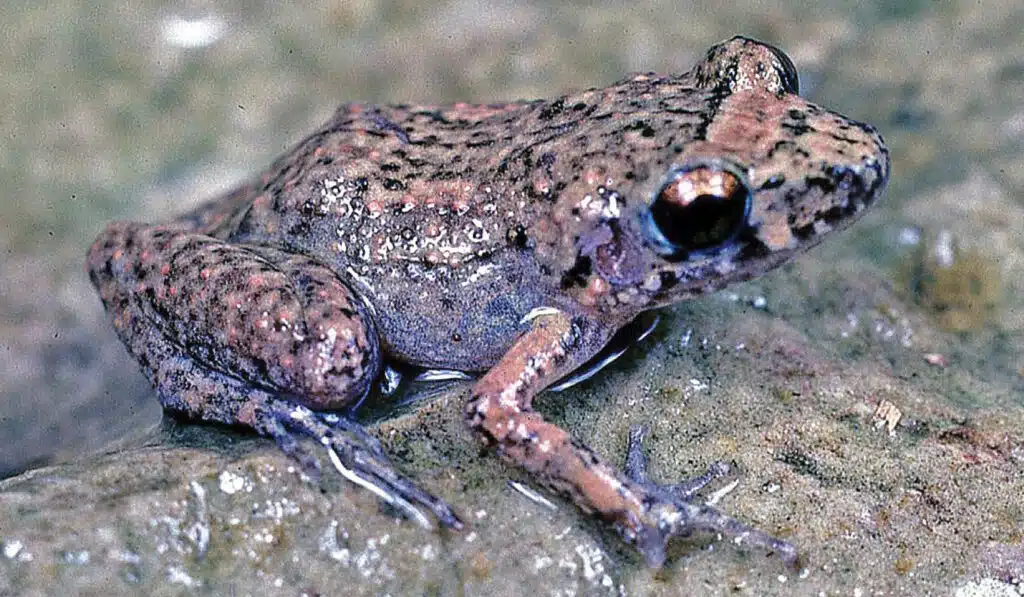
Dark olive color with black spots is specific to the Greenhouse Frog (Eleutherodactylus planirostris).
Native to Cuba, this is one of the introduced species that has multiplied rapidly across the Southern US.
It has been introduced in Florida and it has since spread to Texas.
This species is one of the smallest species in the state. It can be as small as 0.6 inches, with the largest Greenhouse Frogs measuring about an inch.
The species has adapted to its North American habitats and it doesn’t require water to lay eggs in.
Females lay eggs in clumps in a sac under various logs or rocks, areas with higher moisture.
Given it has such a small size, this species can only eat insects and small cockroaches.
It also eats some small spider species.
35. Mexican Smilisca
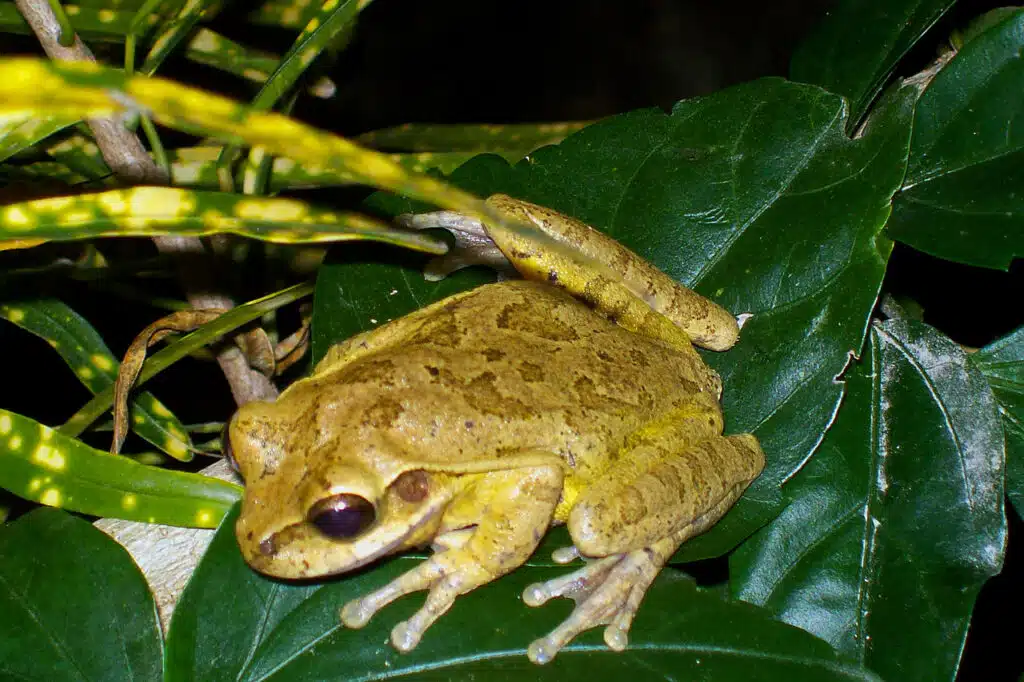
The high coloring variation of the Mexican Smilisca (Smilisca baudinii) makes this species a bit difficult to identify.
Texas has declared Mexican Smilisca an endangered species as it hasn’t been seen on too many occasions over the past years.
The species only survives in a few remote areas of the state.
However, the species has not been seen in more than a decade in many areas of Texas.
It can be identified by its green or brown color. The light green morph has darker green to yellow blotches while the brown morph shows tiny black dots.
Mating rituals are among the few occasions when the Mexican Smilisca may still be located in the state.
It makes high-pitch noises to find mates. Both males and females can make these noises.
36. Crawfish Frog
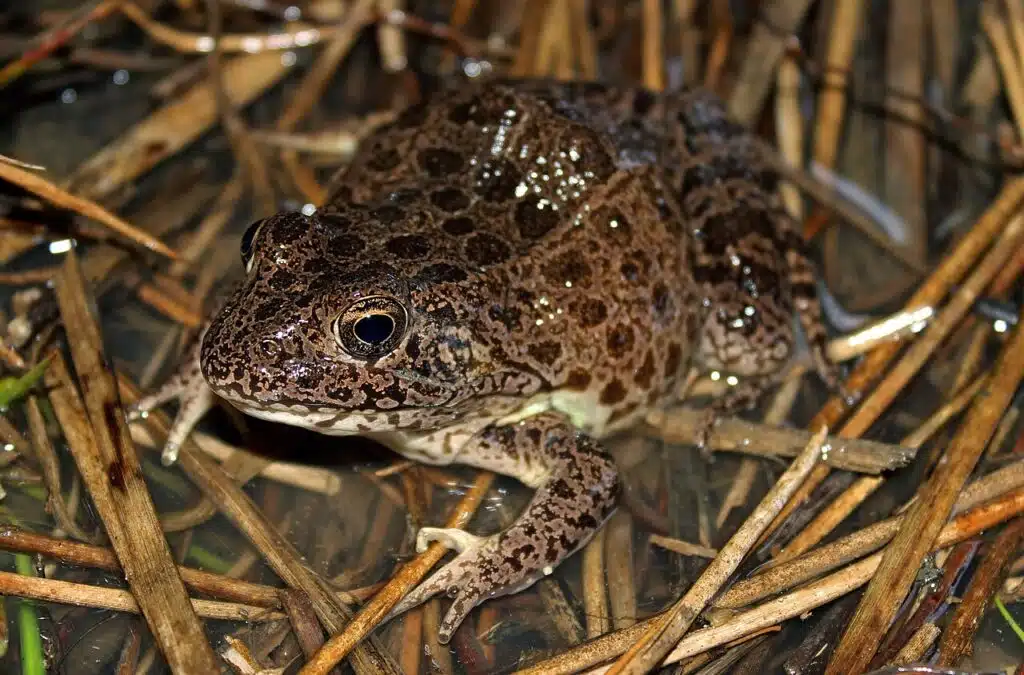
Crawfish Frogs (Lithobates areolatus) are among the first to emerge in the spring. They can be seen from the early days of March.
This species is mostly tied to the burrows of terrestrial crawfish, a habit that inspires its name.
It lives in these shared burrows and rarely moves away from them to a considerable distance.
When threatened, Crawfish Frogs retreat to the same burrows as a means of escape.
The species grows to a size of up to 3 inches and comes in yellow and green colors and other color variations.
Insects represent the bulk of their diet.
Females lay thousands of eggs in the summer.
They prefer bodies of water without any fish to lay eggs as a protective measure.
Males are responsible for finding temporary water sources without fish where they begin to call for females.
37. Mexican Burrowing Toad
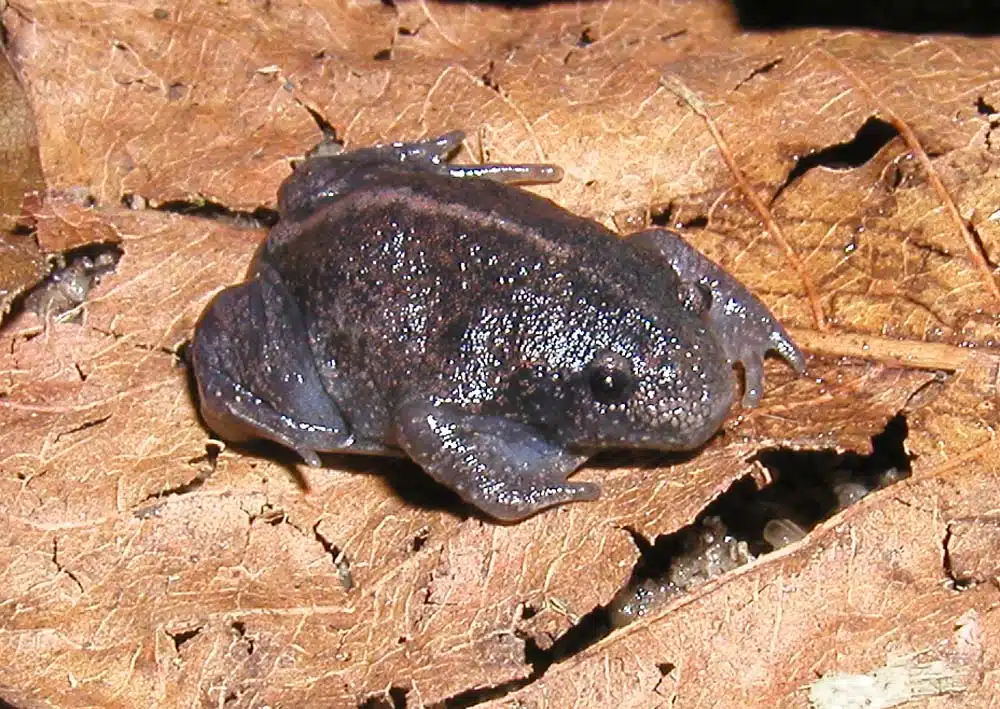
Mexican Burrowing Toads (Rhinophrynus dorsalis) are threatened in Texas. While known for its stable populations in Mexico, the species suffers from excessive urbanization across Texas.
Inland marshes and all types of territories close to water are its natural habitat.
These habitats are seeing more industrialization and the species are facing diminishing numbers in most areas of the state.
Mexican Burrowing Toads have a distinct appearance that makes them stand out from other toads in the state.
They have a black color and square-shaped body. Orange marks and stripes contrast its dorsal side.
Known for having some of the most robust legs in the world of toads, Mexican Burrowing Toads are very efficient at burrowing and nesting underground.
Mating rituals being with the call of the male. Females chose to mate with the males with loud calls and males are the largest.
Since this species spends most of its time underground, it also feeds underground.
It relies on its tongue to catch termites and ants.
38. Barking Frog
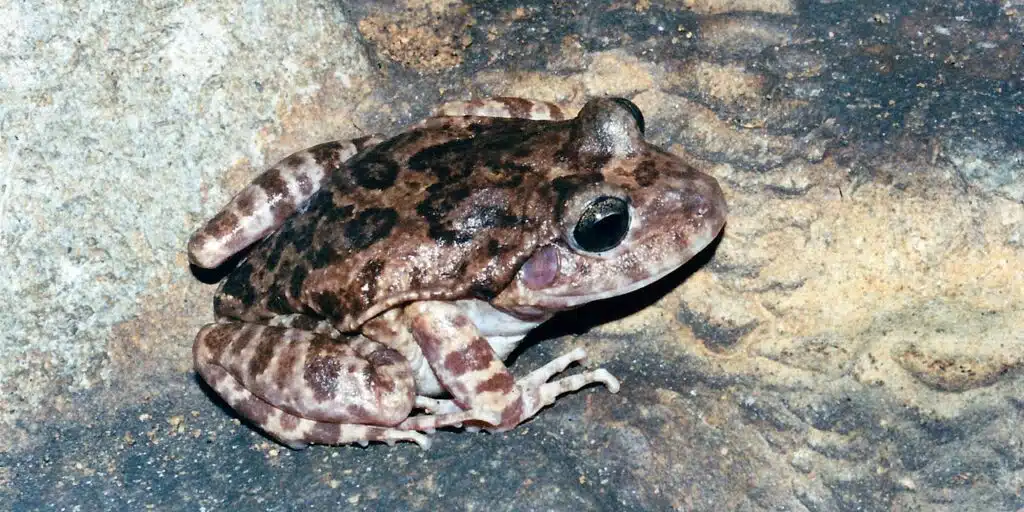
Native to Mexico, Barking Frogs (Craugastor augusti) have also spread to Texas.
This species comes in brown and black colors and it can be one of the rare sights in the state.
Only spotted when mating, this species stands out with its calling which resembles the bark of a dog.
Barking Frogs spend most of their lives underground. Secretive by nature, the species has also shown different types of calls in other areas.
This is one of the first indications Barking Frogs cover different subspecies.
Barking Frogs are also known to lay eggs under rocks, logs, and other objects.
The number of eggs is small but the species still grow in numbers as the eggs hatch directly into juveniles, unlike other species that live in water as tadpoles.
Barking Frogs are a rare sight in Texas, New Mexico, and Arizona compared to their widespread Mexico distribution.
39. Pickerel Frog
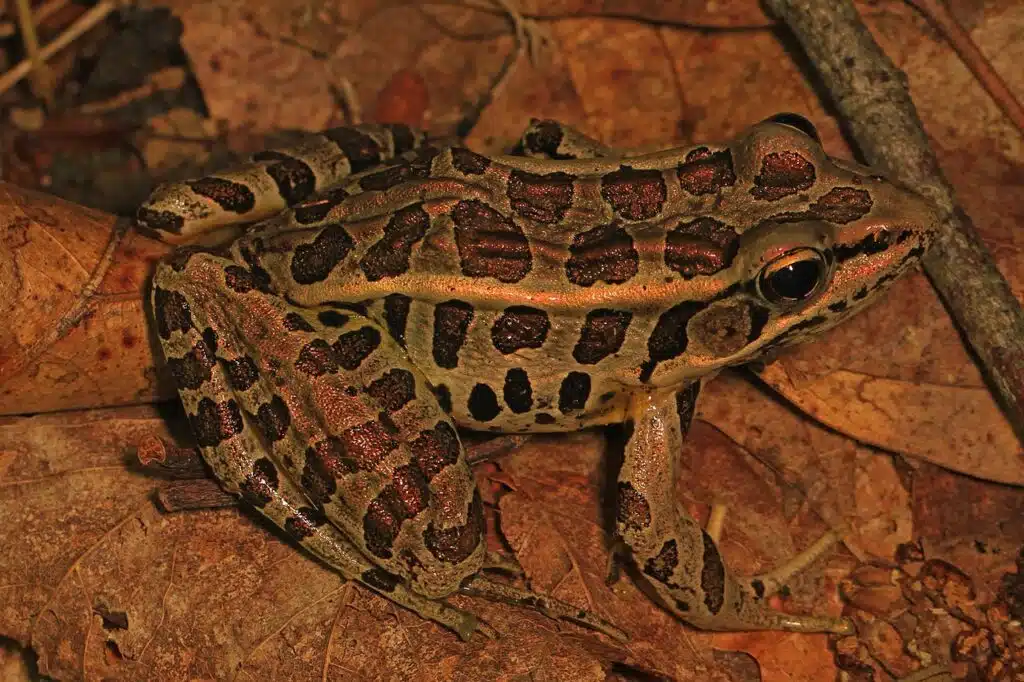
Pickerel Frogs (Lithobates palustris) are sometimes known to be the sole poisonous species in the United States.
Also present in Texas, the species shouldn’t be handled as it causes skin irritation and eye irritation.
Pickerel Frogs are found in East and Northeast Texas.
It produces skin-level chemicals which it only releases when threatened. These chemicals irritate people and they might even kill other types of smaller predators.
The species is identified by its dark patches shaped as squares between wide yellow stripes on its dorsal side.
A fan of cool waters, the species is only seen in May.
It changes colors from green to brown as it matures.
These types of frogs live on or next to water. They often move around bodies of water looking for food.
Pickerel Frogs are opportunistic feeders.
Insects and bugs are among their most common prey. These frogs also consume invertebrates.
Water spiders are also among some of the most common prey to the species.
40. Mexican White-lipped Frog
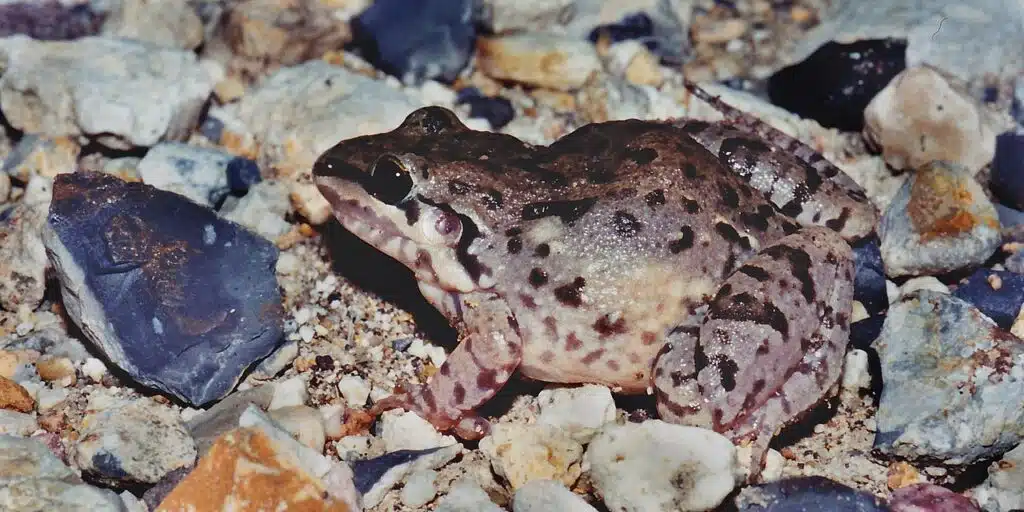
Some of the smallest types of frogs in the state are Mexican White-lipped Frogs (Leptodactylus fragilis). The size of the species varied between 1 and 2 inches.
Mexican White-lipped Frogs are among the few species with a bright stripe on the top lip.
This lateral stripe continues to the central area of the top lip, which inspires its name.
The mottled species is seen in various colors, mainly in brown nuances.
Brown and even black-mottled patterns are specific to the dorsal side of the species.
This species lives in all types of habitats, including in arid areas.
They might sometimes be spotted in the late evenings when they come out for food.
Other Mexican White-lipped Frogs may appear green and black, especially those living in limestone areas.
Grasslands are among its favorites for a high abundance of food. It can also live near various bodies of water with sufficient insects to sustain feeding habits.
Most Mexican White-lipped Frogs in Texas are brown as they live in the ground, in arid conditions.
41. Houston Toad
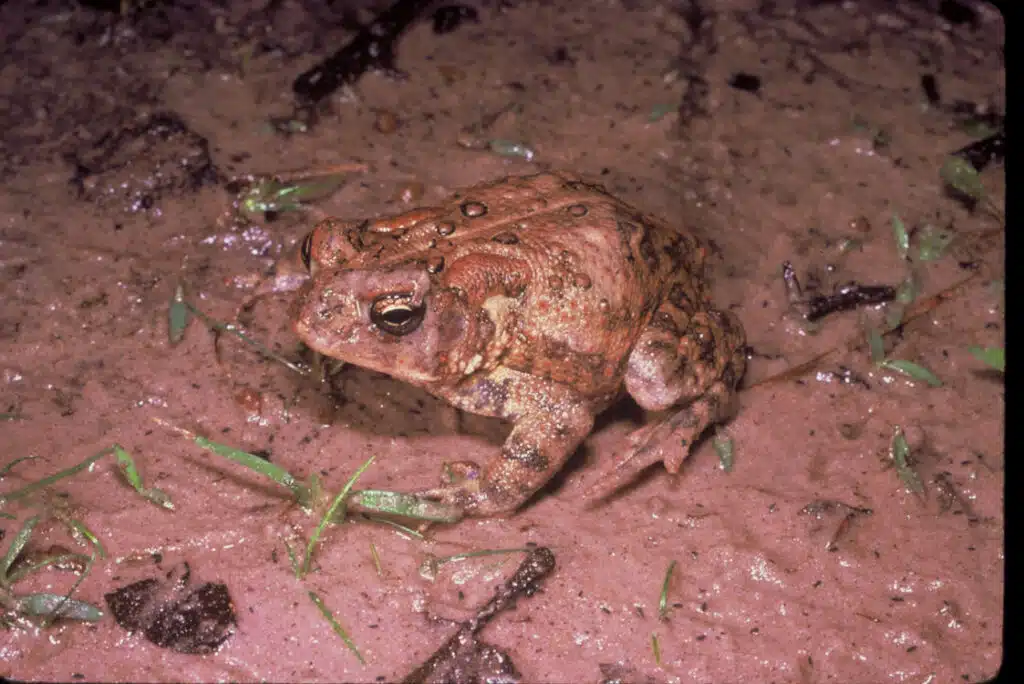
Houston Toads (Anaxyrus houstonensis) are some of the most specific and threatened toads in Texas.
The species only live in specific woodlands across Southeastern Texas. A threatened status has been linked with these toads.
Multiple measures of saving the population have been put in place.
These frogs and toads live in oak and pine woodlands in the state with sandy soils.
They only survive for 2-3 years by hiding in loose sandy soils.
Gray and brown colors are specific cot the species.
The mating strategies of Houston Toads are based on clear high-pitched male calls.
Males start to call females from their burrows early in the evening. They later move on to breeding sights where they continue calling and mate soon after nightfall.
42. Pig Frog
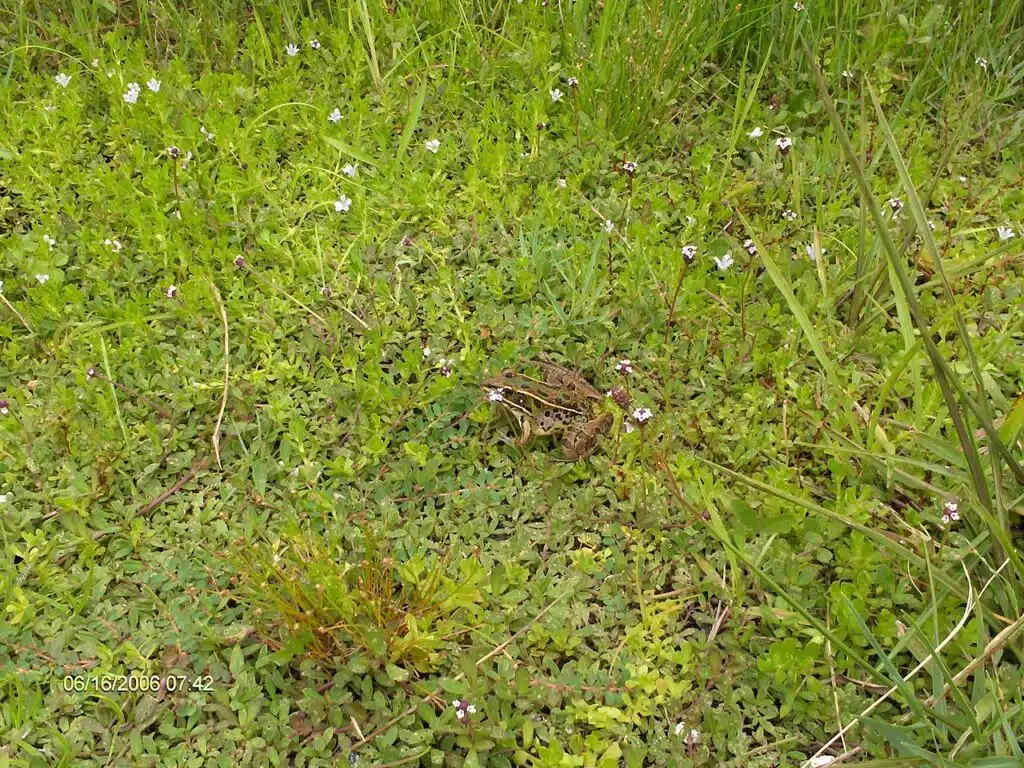
Pig Frogs (Lithobates grylio) are a species found in all types of standing bodies of water or temporary water sources with vegetation.
The species is named after its calls which resemble pig grunt. This type of call can last anywhere between 1 and 2 seconds.
The green color is specific to Pig Frogs, followed by brown or gray colors.
Pig Frogs can come in uniform colors or colors gray or brown blotches.
Only found in swamps and other humid areas at night, Pig Frogs have a diverse diet.
They have opportunistic feeding habitats choosing fish as common prey. Even other types of smaller frogs are part of their diet.
43. Cuban Tree Frog
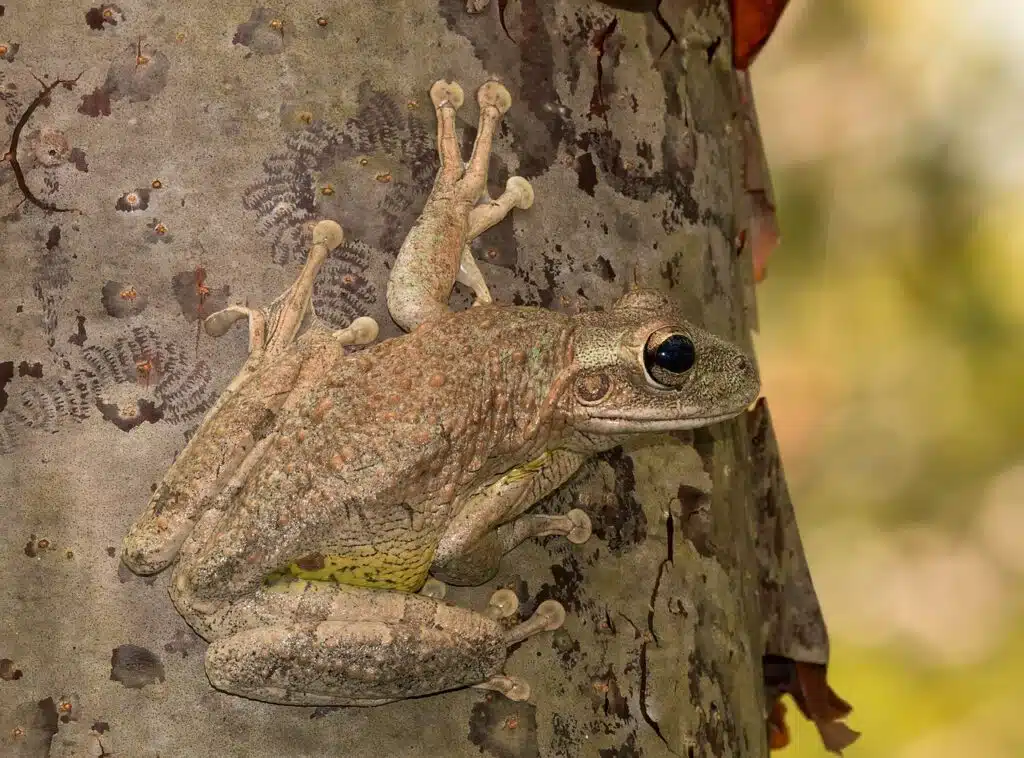
Native to Cuba, these types of frogs (Osteopilus septentrionalis) have a growing presence across Texas.
The species is known for its impact on native tree frogs as it often consumes and eliminates other tree frogs taking advantage of its considerable size.
Cuban Tree Frogs are often considered some of the largest frogs in trees across the continent as they can grow up to 5.5 inches.
They can also be considerably smaller.
A long lifespan and a large body size are among the main reasons the Cuban Tree Frog impacts local ecosystems as much.
Apart from frogs, it also eats lizards and small snakes in Texas and other parts of the country.
Unlike Pig Frogs which only live up to 3 years, Cuban Tree Frogs can survive up to 10 years.
The species comes in different colors from gray to green and even white. It adapts coloring to its ecosystem.
44. Northern Cricket Frog
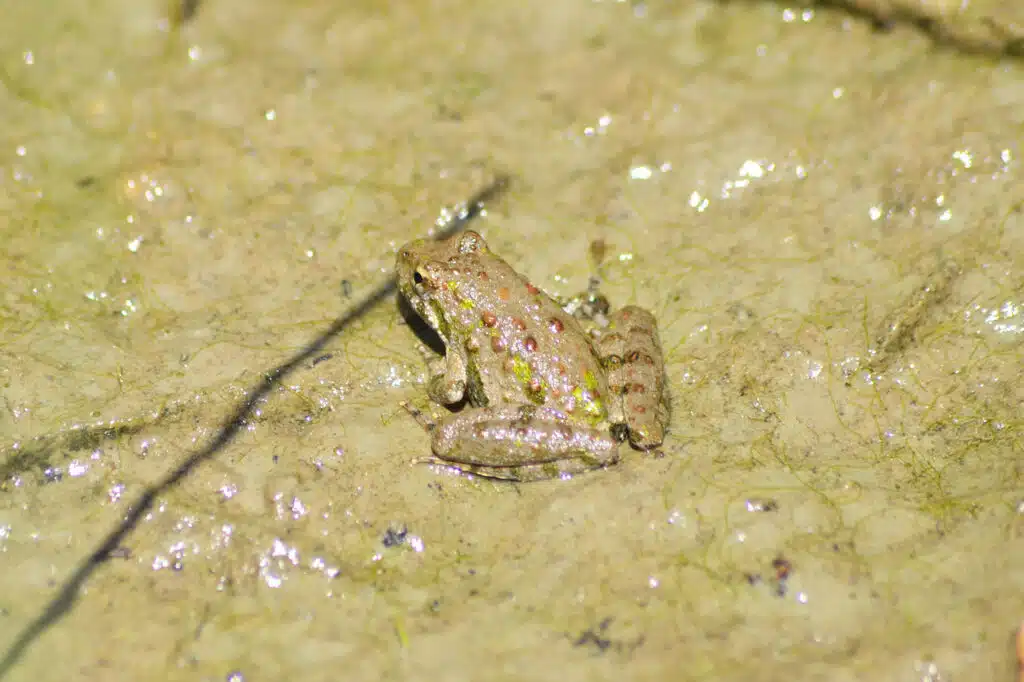
Northern Cricket Frogs (Acris crepitans) are among the common species of Texas.
They live in all parts of the state except the Northwestern territories.
Since they don’t climb trees like other arboreal frogs, these types of frogs are found on the ground, near various sources of water.
Grasshoppers and spiders are commonly part of their diet.
True flies are also some of the most common prey for the Northern Cricket Frog.
Mating calls of the species are loud and often resemble rolling pebbles.
Males that are most dominant when it comes to mating are known to have distinct patterns on the back and to be larger as well.
Other male frogs are known to gravitate towards successful males to blend in and increase mating chances.
45. Upland Chorus Frog
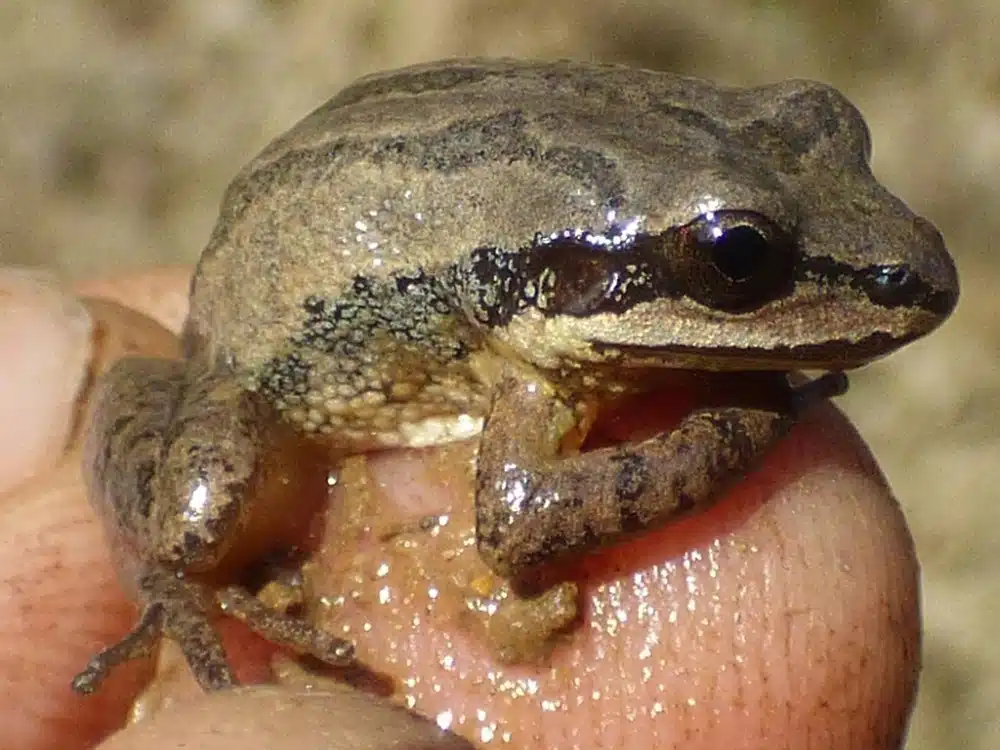
Growing up to a size of 1.5 inches, Upland Chorus Frogs (Pseudacris feriarum) are some of the smallest in the state.
Male Upland Chorus Frogs are often even smaller than 1 inch.
You can find Upland Chorus Frogs in Eastern Texas across various habitats with moderate humidity.
These ground-dwellers are commonly spotted next to bodies of water as long as there’s vegetation for them to hide in or to lay eggs in.
Female Upland Chorus Frogs can lay eggs on vegetation and in water.
Just a few eggs are laid by the female soon after mating.
Upland Chorus Frogs wait for cooler temperatures to mate. Their mating calls and spotting these frogs is easier from November onwards as a result.
46. Spotted Chirping Frog
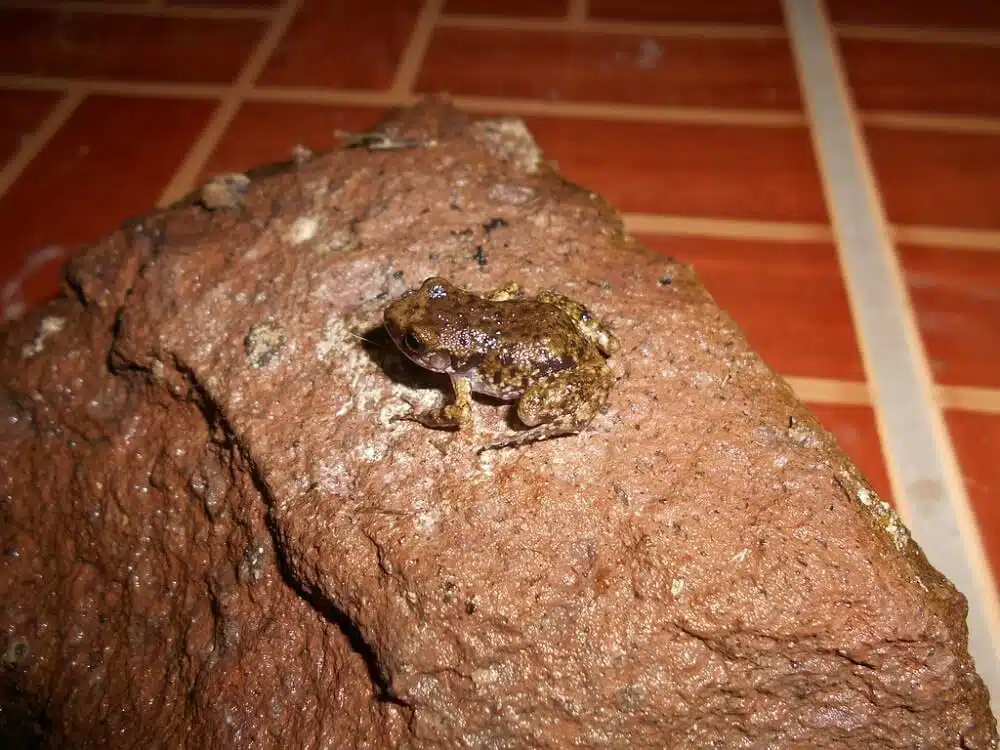
Spotted Chirping Frogs (Eleutherodactylus guttilatus) have gone through various names in time.
These species of frogs are even smaller than Upland Chorus Frogs. They grow to a maximum size between 0.7 inches and 1.2 inches.
Brown and gray coloring are specific to the species.
The species is named after its highly-pitched chirping call.
Found on rocky terrains near water, these frogs have a brown color, with gray or golden-yellow spots and large black eyes.
Ventral coloring is often pink or pink-red.
Adapted to living at altitudes of up to a few thousand feet, Spotted Chirping Frogs are sometimes spotted around Texas’ Davis Mountains.